n Uncategorized · Leave a comment·Edit
by harveyorgan · in Uncategorized · Leave a comment·Edit
GOLD PRICE CLOSE: DOWN $7.40 to $1650.85
SILVER PRICE CLOSE: DOWN $0.05 to $18,68
Access prices: closes
Gold ACCESS CLOSE 1651.50
Silver ACCESS CLOSE: 18.72
New: early yesterday morning//
Bitcoin morning price: $19,566 UP 24
Bitcoin: afternoon price: $19,185 DOWN 357.
Platinum price closing DOWN $6.80 AT $912.85
Palladium price; closing UP $9.25 at $2016.20
END
Due to the huge rise in the dollar, we must look at gold and silver in currencies other than the dollar to understand where we are heading
I will now provide gold in Canadian dollars, British pounds and Euros/4: 15 PM ACCESS
CANADIAN GOLD $2268.80 CDN DOLLARS PER OZ UP $3.68 CDN DOLLARS
BRITISH GOLD IN POUNDS: 1457.60 POUNDS PER OZ UP 5.13 BRITISH POUNDS PER OZ/
EURO GOLD: 1675.00 EUROS PER OZ// DOWN 1.78 EUROS PER OZ///
DONATE
Click here if you wish to send a donation. I sincerely appreciate it as this site takes a lot of preparation.
EXCHANGE: COMEX
EXCHANGE: COMEX
CONTRACT: OCTOBER 2022 COMEX 100 GOLD FUTURES
SETTLEMENT: 1,657.000000000 USD
INTENT DATE: 10/17/2022 DELIVERY DATE: 10/19/2022
FIRM ORG FIRM NAME ISSUED STOPPED
118 C MACQUARIE FUT 54
323 C HSBC 47
657 C MORGAN STANLEY 4
905 C ADM 3
TOTAL: 54 54
MONTH TO DATE: 22,259
JPMORGAN STOPPED 0/54
GOLD: NUMBER OF NOTICES FILED FOR OCT CONTRACT: 54 NOTICES FOR 5400 OZ or 0.1617 TONNES
total notices so far: 22,259 contracts for 2,225,900 oz (69.235 tonnes)
SILVER NOTICES: 2 NOTICE(S) FILED FOR 10,000 OZ/
total number of notices filed so far this month 439 : for 2,145,000 oz
END
Russia is a major supplier of silver to London while Mexico supplies the COMEX
With the sanctions, London has no way to obtain silver other than compete with NY.
GLD
WITH GOLD DOWN $7.40
WITH RESPECT TO GLD WITHDRAWALS: (OVER THE PAST FEW MONTHS):
GOLD IS “RETURNED” TO THE BANK OF ENGLAND WHEN CALLING IN THEIR LEASES: THE GOLD NEVER LEAVES THE BANK OF ENGLAND IN THE FIRST PLACE. THE BANK IS PROTECTING ITSELF IN CASE OF COMMERCIAL FAILURE
ALSO INVESTORS SWITCHING TO SPROTT PHYSICAL (PHYS) INSTEAD OF THE FRAUDULENT GLD//BIG CHANGES IN GOLD INVENTORY AT THE GLD: /////A WITHDRAWAL OF 2.03 TONNES INTO THE GLD//
INVENTORY RESTS AT 939.10 TONNES
Silver//SLV
WITH NO SILVER AROUND AND SILVER DOWN 5 CENTS
AT THE SLV// :/BIG CHANGES IN SILVER INVENTORY AT THE SLV//: A HUGE DEPOSIT OF 1.658 MILLION OZ INTO THE SLV
INVESTORS ARE SWITCHING SLV TO SPROTT’S PSLV
CLOSING INVENTORY: 487.729 MILLION OZ
Let us have a look at the data for today
SILVER//OUTLINE
SILVER COMEX OI FELL BY A HUGE SIZED 1021 CONTRACTS TO 135,304 AND FURTHER FROM THE RECORD HIGH OI OF 244,710, SET FEB 25/2020 AND THE GIGANTIC GAIN IN COMEX OI WAS ACCOMPLISHED DESPITE OUR $0.53 GAIN IN SILVER PRICING AT THE COMEX ON MONDAY. OUR BANKERS/HFT WERE SUCCESSFUL IN KNOCKING THE PRICE OF SILVER DOWN (IT ROSE BY $0.53)., BUT UNSUCCESSFUL IN KNOCKING OFF ANY SPEC LONGS. HUGE NUMBERS OF SPECS CONTINUE TO ADD TO THEIR SHORTFALLS FROM WHICH OUR BANKERS CONTINUE TO BE PURCHASERS OF NET COMEX LONGS.
WE MUST HAVE HAD:
I) STRONG SPECULATOR SHORT COVERINGS ////CONTINUED BANKER OI COMEX ADDITIONS /// CONSIDERABLE NEWBIE SPEC LONG ADDITIONS. II) WE ALSO HAD SOME REDDIT RAPTOR BUYING//. iii) A STRONG ISSUANCE OF EXCHANGE FOR PHYSICALS iiii) AN INITIAL SILVER STANDING FOR COMEX SILVER MEASURING AT 1.580 MILLION OZ FOLLOWING A 415,000 OZ QUEUE JUMP / // V) GIGANTIC SIZED COMEX OI LOSS/
I AM NOW RECORDING THE DIFFERENTIAL IN OI FROM PRELIMINARY TO FINAL: +12
HISTORICAL ACCUMULATION OF EXCHANGE FOR PHYSICALS OCT. ACCUMULATION FOR EFP’S SILVER/JPMORGAN’S HOUSE OF BRIBES/STARTING FROM FIRST DAY/MONTH OF OCT:
TOTAL CONTRACTS for 14 days, total 54,197 contracts: 27.0985 million oz OR 1.935MILLION OZ PER DAY. (387 CONTRACTS PER DAY)
TOTAL EFP’S FOR THE MONTH SO FAR: 27 MILLION OZ
.
LAST 17 MONTHS TOTAL EFP CONTRACTS ISSUED IN MILLIONS OF OZ:
MAY 137.83 MILLION
JUNE 149.91 MILLION OZ
JULY 129.445 MILLION OZ
AUGUST: MILLION OZ 140.120
SEPT. 28.230 MILLION OZ//
OCT: 94.595 MILLION OZ
NOV: 131.925 MILLION OZ
DEC: 100.615 MILLION OZ
JAN 2022// 90.460 MILLION OZ
FEB 2022: 72.39 MILLION OZ//
MARCH: 207.430 MILLION OZ//A NEW RECORD FOR EFP ISSUANCE
APRIL: 114.52 MILLION OZ FINAL//LOW ISSUANCE
MAY: 105.635 MILLION OZ//
JUNE: 94.470 MILLION OZ
JULY : 87.110 MILLION OZ
AUGUST: 65.025 MILLION OZ
SEPT. 74.025 MILLION OZ///FINAL
OCT. 27.0985 MILLION OZ INITIAL
RESULT: WE HAD A GIGANTIC SIZED DECREASE IN COMEX OI SILVER COMEX CONTRACTS OF 1021 DESPITE OUR HUGE $0.53 GAIN IN SILVER PRICING AT THE COMEX// MONDAY.,. THE CME NOTIFIED US THAT WE HAD A STRONG SIZED EFP ISSUANCE CONTRACTS: 950 CONTRACTS ISSUED FOR DEC AND 0 CONTRACTS ISSUED FOR ALL OTHER MONTHS) WHICH EXITED OUT OF THE SILVER COMEX TO LONDON AS FORWARDS THE DOMINANT FEATURE TODAY: /STRONG BANKER ADDITIONS // STRONG SHORT ADDITIONS//CONSIDERABLE NEWBIE SPEC LONG ADDITIONS// /// WE HAVE A GOOD INITIAL SILVER OZ STANDING FOR OCT. OF 1.580 MILLION OZ FOLLOWED BY TODAY’S 415,000 QUEUE JUMP .. WE HAD A SMALL SIZED LOSS OF 71 OI CONTRACTS ON THE TWO EXCHANGES FOR 0.355 MILLION OZ..
WE HAD 2 NOTICE(S) FILED TODAY FOR 10,000 OZ
THE SILVER COMEX IS NOW BEING ATTACKED FOR METAL BY LONDONERS ET AL.
GOLD//OUTLINE
IN GOLD, THE COMEX OPEN INTEREST FELL BY A GOOD SIZED 4392 CONTRACTS TO 432,976 AND FURTHER FROM THE RECORD (SET JAN 24/2020) AT 799,541 AND PREVIOUS TO THAT: (SET JAN 6/2020) AT 797,110. WE WILL PROBABLY SEE THE COMEX OI FALL TO AROUND 380,000 AS OUR SPECS GET ANNIHILATED.
THE DIFFERENTIAL FROM PRELIMINARY OI TO FINAL OI IN GOLD TODAY: REMOVED — -213 CONTRACTS.
.
THE GOOD SIZED INCREASE IN COMEX OI CAME DESPITE OUR GAIN IN PRICE OF $14.55//COMEX GOLD TRADING/MONDAY // CONSIDERABLE SPECULATOR SHORT COVERINGS ACCOMPANYING OUR FAIR SIZED EXCHANGE FOR PHYSICAL ISSUANCE./. WE HAD ZERO LONG LIQUIDATION //AND CONTINUED ADDITIONS TO OUR BANKER LONGS!! THE COMEX WILL BLOW UP AS THE SPECS CANNOT DELIVER GOLD TO OUR BANKER LONGS.
WE ALSO HAD A HUGE INITIAL STANDING IN GOLD TONNAGE FOR OCT. AT 66.099 TONNES ON FIRST DAY NOTICE FOLLOWED BY TODAY’S QUEUE. JUMP OF 12,200 OZ//NEW STANDING 71.284TONNES (QUEUE JUMPING = EXERCISING LONDON BASED EFP’S WILL CONTINUE UNTIL MONTH’S END)
YET ALL OF..THIS HAPPENED WITH OUR GAIN IN PRICE OF $14.55 WITH RESPECT TO MONDAY’S TRADING
WE HAD A SMALL SIZED LOSS OF 4638 OI CONTRACTS 5.095 PAPER TONNES) ON OUR TWO EXCHANGES..
E.F.P. ISSUANCE
THE CME RELEASED THE DATA FOR EFP ISSUANCE AND IT TOTALED A FAIR SIZED 2754 CONTRACTS:
The NEW COMEX OI FOR THE GOLD COMPLEX RESTS AT 432,976
IN ESSENCE WE HAVE A SMALL SIZED DECREASE IN TOTAL CONTRACTS ON THE TWO EXCHANGES OF 1638 CONTRACTS WITH 4392 CONTRACTS DECREASED AT THE COMEX AND 2754 EFP OI CONTRACTS WHICH NAVIGATED OVER TO LONDON. THUS TOTAL OI LOSS ON THE TWO EXCHANGES OF 1638 CONTRACTS OR 5.095 TONNES.
CALCULATIONS ON GAIN/LOSS ON OUR TWO EXCHANGES
WE HAD A FAIR SIZED ISSUANCE IN EXCHANGE FOR PHYSICALS (2754) ACCOMPANYING THE GOOD SIZED LOSS IN COMEX OI (4392): TOTAL LOSS IN THE TWO EXCHANGES 1425 CONTRACTS. WE NO DOUBT HAD 1) CONSIDERABLE SPECULATOR SHORT COVERINGS// CONTINUED GOOD BANKER ADDITIONS/// STRONG NEWBIE SPEC ADDITIONS ,2.) STRONG INITIAL STANDING AT THE GOLD COMEX FOR OCT. AT 66.099 TONNES FOLLOWED BY TODAY’S 12,200 OZ QUEUE. JUMP ///NEW STANDING 71.284 TONNES//. 3) ZERO LONG LIQUIDATION //// //.,4) GOOD SIZED COMEX OPEN INTEREST LOSS 5) FAIR ISSUANCE OF EXCHANGE FOR PHYSICAL/
HISTORICAL ACCUMULATION OF EXCHANGE FOR PHYSICALS IN 2022 INCLUDING TODAY
OCT
ACCUMULATION OF EFP’S GOLD AT J.P. MORGAN’S HOUSE OF BRIBES: (EXCHANGE FOR PHYSICAL) FOR THE MONTH OF OCT. :
33,111 CONTRACTS OR 3,311,100 OZ OR 102.989 TONNES 14 TRADING DAY(S) AND THUS AVERAGING: 2365 EFP CONTRACTS PER TRADING DAY
TO GIVE YOU AN IDEA AS TO THE SIZE OF THESE EFP TRANSFERS : THIS MONTH IN 14 TRADING DAY(S) IN TONNES: 102.989 TONNES
TOTAL ANNUAL GOLD PRODUCTION, 2021, THROUGHOUT THE WORLD EX CHINA EX RUSSIA: 3555 TONNES
THUS EFP TRANSFERS REPRESENTS 102.989/3550 x 100% TONNES 2.90% OF GLOBAL ANNUAL PRODUCTION
ACCUMULATION OF GOLD EFP’S YEAR 2021 TO 2022
JANUARY/2021: 265.26 TONNES (RAPIDLY INCREASING AGAIN)
FEB : 171.24 TONNES ( DEFINITELY SLOWING DOWN AGAIN)..
MARCH:. 276.50 TONNES (STRONG AGAIN/
APRIL: 189..44 TONNES ( DRAMATICALLY SLOWING DOWN AGAIN//GOLD IN BACKWARDATION)
MAY: 250.15 TONNES (NOW DRAMATICALLY INCREASING AGAIN)
JUNE: 247.54 TONNES (FINAL)
JULY: 188.73 TONNES FINAL
AUGUST: 217.89 TONNES FINAL ISSUANCE.
SEPT 142.12 TONNES FINAL ISSUANCE ( LOW ISSUANCE)_
OCT: 141.13 TONNES FINAL ISSUANCE (LOW ISSUANCE)
NOV: 312.46 TONNES FINAL ISSUANCE//NEW RECORD!! (INCREASING DRAMATICALLY)//SIGN OF REAL STRESS//SURPASSING THE MARCH 2021 RECORD OF 276.50 TONNES OF EFP
DEC. 175.62 TONNES//FINAL ISSUANCE//
JAN:2022 247.25 TONNES //FINAL
FEB: 196.04 TONNES//FINAL
MARCH: 409.30 TONNES INITIAL( THIS IS NOW A RECORD EFP ISSUANCE FOR MARCH AND FOR ANY MONTH.
APRIL: 169.55 TONNES (FINAL VERY LOW ISSUANCE MONTH)
MAY: 247,44 TONNES FINAL//
JUNE: 238.13 TONNES FINAL
JULY: 378.43 TONNES FINAL
AUGUST: 180.81 TONNES FINAL
SEPT. 193.16 TONNES FINAL
OCT: 102.989 TONNES INITIAL ( MUCH SMALLER THAN LAST MONTH)
SPREADING OPERATIONS
(/NOW SWITCHING TO GOLD) FOR NEWCOMERS, HERE ARE THE DETAILS
SPREADING LIQUIDATION HAS NOW COMMENCED AS WE HEAD TOWARDS THE NEW NON ACTIVE FRONT MONTH OF NOV. WE ARE NOW INTO THE SPREADING OPERATION OF BOTH SILVER AND GOLD (WILL BE SMALL AS SPREADERS DO NOT PAY ATTENTION TO NOVEMBER)
HERE IS A BRIEF SYNOPSIS OF HOW THE CROOKS FLEECE UNSUSPECTING LONGS IN THE SPREADING ENDEAVOUR ;MODUS OPERANDI OF THE CORRUPT BANKERS AS TO HOW THEY HANDLE THEIR SPREAD OPEN INTERESTS:HERE IS HOW THE CROOKS USED SPREADING AS WE ARE NOW INTO THE NON ACTIVE DELIVERY MONTH OF OCT HEADING TOWARDS THE NON ACTIVE DELIVERY MONTH OF NOV., FOR BOTH GOLD AND SILVER:
YOU WILL ALSO NOTICE THAT THE COMEX OPEN INTEREST STARTS TO RISE BUT SO IS THE OPEN INTEREST OF SPREADERS. THE OPEN INTEREST IN WILL CONTINUE TO RISE UNTIL ONE WEEK BEFORE FIRST DAY NOTICE OF AN UPCOMING ACTIVE DELIVERY MONTH (NOV), AND THAT IS WHEN THE CROOKS SELL THEIR SPREAD POSITIONS BUT NOT AT THE SAME TIME OF THE DAY. THEY WILL USE THE SELL SIDE OF THE EQUATION TO CREATE THE CASCADE (ALONG WITH THEIR COLLUSIVE FRIENDS) AND THEN COVER ON THE BUY SIDE OF THE SPREAD SITUATION AT THE END OF THE DAY. THEY DO THIS TO AVOID POSITION LIMIT DETECTION. THE LIQUIDATION OF THE SPREADING FORMATION CONTINUES FOR EXACTLY ONE WEEK AND ENDS ON FIRST DAY NOTICE.”
WHAT IS ALARMING TO ME, ACCORDING TO OUR LONDON EXPERT ANDREW MAGUIRE IS THAT THESE EFP’S ARE BEING TRANSFERRED TO WHAT ARE CALLED SERIAL FORWARD CONTRACT OBLIGATIONS AND THESE CONTRACTS ARE LESS THAN 14 DAYS. ANYTHING GREATER THAN 14 DAYS, THESE MUST BE RECORDED AND SENT TO THE COMPTROLLER, GREAT BRITAIN TO MONITOR RISK TO THE BANKING SYSTEM. IF THIS IS INDEED TRUE, THEN THIS IS A MASSIVE CONSPIRACY TO DEFRAUD AS WE NOW WITNESS A MONSTROUS TOTAL EFP’S ISSUANCE AS IT HEADS INTO THE STRATOSPHERE.
First, here is an outline of what will be discussed tonight:
1.Today, we had the open interest at the comex, in SILVER, FELL BY A GIGANTIC SIZED 1021 CONTRACT OI TO 135,304 AND CLOSER TO OUR COMEX HIGH RECORD //244,710(SET FEB 25/2020). THE LAST RECORDS WERE SET IN AUG.2018 AT 244,196 WITH A SILVER PRICE OF $14.78/(AUGUST 22/2018)..THE PREVIOUS RECORD TO THAT WAS SET ON APRIL 9/2018 AT 243,411 OPEN INTEREST CONTRACTS WITH THE SILVER PRICE AT THAT DAY: $16.53). AND PREVIOUS TO THAT, THE RECORD WAS ESTABLISHED AT: 234,787 CONTRACTS, SET ON APRIL 21.2017 OVER 5 YEARS AGO.
EFP ISSUANCE 950 CONTRACTS
OUR CUSTOMARY MIGRATION OF COMEX LONGS CONTINUE TO MORPH INTO LONDON FORWARDS AS OUR BANKERS USED THEIR EMERGENCY PROCEDURE TO ISSUE:
DEC 950 ALL OTHER MONTHS: ZERO. TOTAL EFP ISSUANCE: 950 CONTRACTS. EFP’S GIVE OUR COMEX LONGS A FIAT BONUS PLUS A DELIVERABLE PRODUCT OVER IN LONDON. IF WE TAKE THE COMEX OI LOSS OF 10321 CONTRACTS AND ADD TO THE 950 OI TRANSFERRED TO LONDON THROUGH EFP’S,
WE OBTAIN A SMALL SIZED LOSS OF 71 OPEN INTEREST CONTRACTS FROM OUR TWO EXCHANGES.
THUS IN OUNCES, THE LOSS ON THE TWO EXCHANGES 0.355 MILLION OZ//
OCCURRED DESPITE OUR GAIN IN PRICE OF $0.53
OUTLINE FOR TODAY’S COMMENTARY
1/COMEX GOLD AND SILVER REPORT
(report Harvey)
2 ) Gold/silver trading overnight Europe,
(Peter Schiff,
end
3. Egon von Greyerz///Matthew Piepenburg via GoldSwitzerland.com,
4. Chris Powell of GATA provides to us very important physical commentaries
end
5. Other gold commentaries
6. Commodity commentaries//
3. ASIAN AFFAIRS
i)TUESDAY MORNING// MONDAY NIGHT
SHANGHAI CLOSED DOWN 3.98 PTS OR 0.13% //Hang Seng CLOSED UP 301.68 OR 1.82% /The Nikkei closed UP 380.35PTS OR 1.42% //Australia’s all ordinaires CLOSED UP 1.78% /Chinese yuan (ONSHORE) closed UP TO 7.1994 //OFFSHORE CHINESE YUAN UP 7.20985// /Oil DOWN TO 85.56 dollars per barrel for WTI and BRENT AT 91.55 / Stocks in Europe OPENED ALL GREEN. ONSHORE YUAN TRADING ABOVE LEVEL OF OFFSHORE YUAN/ONSHORE YUAN TRADING STRONGER AGAINST US DOLLAR/OFFSHORE STRONGER
a)NORTH KOREA/SOUTH KOREA
outline
b) REPORT ON JAPAN/
OUTLINE
3 C CHINA
OUTLINE
4/EUROPEAN AFFAIRS
OUTLINE
5. RUSSIAN AND MIDDLE EASTERN AFFAIRS
OUTLINE
6.Global Issues//COVID ISSUES/VACCINE ISSUES
OUTLINE
7. OIL ISSUES
OUTLINE
8 EMERGING MARKET ISSUES
COMEX DATA//AMOUNTS STANDING//VOLUME OF TRADING/INVENTORY MOVEMENTS
GOLD
LET US BEGIN:
THE TOTAL COMEX GOLD OPEN INTEREST FELL BY A GOOD SIZED 4392 CONTRACTS TO 432,976 AND FURTHER FROM THE RECORD THAT WAS SET IN JANUARY/2020: {799,541 OI(SET JAN 16/2020)} AND PREVIOUS TO THAT: 797,110 (SET JAN 7/2020). AND THIS GOOD COMEX DECREASE OCCURRED DESPITE OUR RISE IN PRICE OF $14.55 IN GOLD PRICING MONDAY’S COMEX TRADING. WE ALSO HAD A FAIR SIZED EFP (2754 CONTRACTS). . THEY WERE PAID HANDSOMELY NOT TO TAKE DELIVERY AT THE COMEX AND SETTLE FOR CASH. IT NOW SEEMS THAT THE COMMERCIALS HAVE GOADED THE SPECS TO GO MASSIVELY SHORT AND NOW THEY ARE DESPERATELY TRYING TO COVER THEIR FOLLY.
WE NORMALLY HAVE WITNESSED EXCHANGE FOR PHYSICALS ISSUED BEING SMALL AS IT JUST TOO COSTLY FOR THEM TO CONTINUE SERVICING THE COSTS OF SERIAL FORWARDS CIRCULATING IN LONDON. HOWEVER, MUCH TO THE ANNOYANCE OF OUR BANKERS, THE COMEX IS THE SCENE OF AN ASSAULT ON GOLD AS LONDONERS, NOT BEING ABLE TO FIND ANY PHYSICAL ON THAT SIDE OF THE POND, EXERCISE THESE CIRCULATING EXCHANGE FOR PHYSICALS IN LONDON AND FORCING DELIVERY OF REAL METAL OVER HERE AS THE OBLIGATION STILL RESTS WITH NEW YORK BANKERS. IT SEEMS THAT ARE BANKERS FRIENDS ARE EXERCISING EFP’S FROM LONDON AND NOW THEY ARE LOATHE TO ISSUE NEW ONES.
EXCHANGE FOR PHYSICAL ISSUANCE
WE ARE NOW IN THE ACTIVE DELIVERY MONTH OF OCT.. THE CME REPORTS THAT THE BANKERS ISSUED A FAIR SIZED TRANSFER THROUGH THE EFP ROUTE AS THESE LONGS RECEIVED A DELIVERABLE LONDON FORWARD TOGETHER WITH A FIAT BONUS.,
THAT IS 2754 EFP CONTRACTS WERE ISSUED: ;: , . 0 DEC : 2754 & ZERO FOR ALL OTHER MONTHS:
TOTAL EFP ISSUANCE: 2754 CONTRACTS
WHEN WE HAVE BACKWARDATION, EFP ISSUANCE IS VERY COSTLY BUT THE REAL PROBLEM IS THE SCARCITY OF METAL AND IT IS FAR BETTER FOR OUR BANKERS TO PAY OFF INDIVIDUALS THAN RISK INVESTORS ESPECIALLY FROM LONDON STANDING FOR DELIVERY. THE LOWER PRICES IN THE FUTURES MARKET IS A MAGNET FOR OUR LONDONERS SEEKING PHYSICAL METAL. BACKWARDATION ALWAYS EQUAL SCARCITY OF METAL!
ON A NET BASIS IN OPEN INTEREST WE LOST THE FOLLOWING TODAY ON OUR TWO EXCHANGES: A SMALL SIZED TOTAL OF 1638 CONTRACTS IN THAT 2754 LONGS WERE TRANSFERRED AS FORWARDS TO LONDON AND WE HAD A GOOD SIZED COMEX OI LOSS OF 4392 CONTRACTS..AND THIS FAIR SIZED LOSS ON OUR TWO EXCHANGES HAPPENED DESPITE OUR RISE IN PRICE OF GOLD $14.55//WE HAD SPEC SHORTS COVERING SOME OF THEIR POSITIONS WITH BANKERS ALSO AS BUYERS OF COMEX GOLD CONTRACTS. WE ALSO HAD SOME ADDITIONAL NEWBIE SPECS GOING CASHING OUT FOR SOME PROFITS ON THE RISE IN PRICE.
// WE HAVE A STRONG AMOUNT OF GOLD TONNAGE STANDING OCT (71.284),
HERE ARE THE AMOUNTS THAT STOOD FOR DELIVERY IN THE PRECEDING 12 MONTHS OF 2021-2022:
DEC 2021: 112.217 TONNES
NOV. 8.074 TONNES
OCT. 57.707 TONNES
SEPT: 11.9160 TONNES
AUGUST: 80.489 TONNES
JULY: 7.2814 TONNES
JUNE: 72.289 TONNES
MAY 5.77 TONNES
APRIL 95.331 TONNES
MARCH 30.205 TONNES
FEB ’21. 113.424 TONNES
JAN ’21: 6.500 TONNES.
TOTAL SO FAR THIS YEAR (JAN- DEC): 601.213 TONNES
YEAR 2022:
JANUARY 2022 17.79 TONNES
FEB 2022: 59.023 TONNES
MARCH: 36.678 TONNES
APRIL: 85.340 TONNES FINAL.
MAY: 20.11 TONNES FINAL
JUNE: 74.933 TONNES FINAL
JULY 29.987 TONNES FINAL
AUGUST:104.979 TONNES//FINAL
SEPT. 38.1158 TONNES
OCT: 71.284 TONNES
THE SPECS/HFT WERE UNSUCCESSFUL IN LOWERING GOLD’S PRICE //// (IT ROSE $14.55) AND WERE UNSUCCESSFUL IN KNOCKING OFF ANY SPECULATOR LONGS (THEY ADDED TO THEIR POSITIONS) AS WE HAD A FAIR SIZED TOTAL LOSS ON OUR TWO EXCHANGES OF 1638 CONTRACTS // WE HAVE REGISTERED A SMALL LOSS OF 5.095 PAPER TONNES ON TOTAL OI FROM OUR TWO EXCHANGES, ACCOMPANYING OUR GOLD TONNAGE STANDING FOR OCT. (71.284 TONNES)…THIS WAS ACCOMPLISHED WITH A RISE IN PRICE OF $14.55
WE HAD -213 CONTRACTS COMEX TRADES REMOVED. THESE WERE REMOVED AFTER TRADING ENDED LAST NIGHT
NET LOSS ON THE TWO EXCHANGES 1638 CONTRACTS OR 163,800 OZ OR 5.095 TONNES
Estimated gold volume 156,925// poor//
final gold volumes/yesterday 153,085/ poor
INITIAL STANDINGS FOR OCT ’22 COMEX GOLD //OCT 18
| Gold | Ounces |
| Withdrawals from Dealers Inventory in oz | nil oz |
| Withdrawals from Customer Inventory in oz | 739.46oz Brinks 23 kilobars |
| Deposit to the Dealer Inventory in oz | nil |
| Deposits to the Customer Inventory, in oz | 1101.154 oz Brinks |
| No of oz served (contracts) today | 54 notice(s) 5400 OZ 0.1679 TONNES |
| No of oz to be served (notices) | 659 contracts 65,900oz 2.049 TONNES |
| Total monthly oz gold served (contracts) so far this month | 22,259 notices 2,225,900 69.235 TONNES |
| Total accumulative withdrawals of gold from the Dealers inventory this month | NIL oz |
| Total accumulative withdrawal of gold from the Customer inventory this month | xxx oz |
total dealer deposit 0
total dealer deposit: nil oz
No dealer withdrawals
Customer deposits: 0
total deposits nil oz
customer withdrawals:1
i) Out of Brinks 739.46 oz (23 kilobars)
total: 739.46 oz
total in tonnes: 0.022 tonnes
Adjustments: 4// all dealer to customer
i)HSBC 29,305.136 oz
ii) JPMorgan 65,360.482 oz
iii) Manfra 35,687,610 oz
iv) Brinks 15,461.975 oz
total: 145,815.197 oz moved out of registered to eligible//used for deliveries
CALCULATIONS FOR THE AMOUNT OF GOLD STANDING FOR OCT.
For the front month of OCT we have an oi of 713 contracts having GAINED 122 contracts . We had 0 contracts
filed on MONDAY, so we GAINED A STRONG 122 contracts or an additional 12,200 oz will stand in this active delivery month of Oct. From this point
we should gain in total gold standing through to the end of Oct.( This is queue jumping and in reality it is the exercising of London based EFP;s for gold at the comex)
November GAINED 182 contracts to stand at 3304
December LOST 4631 contracts up to 357,355
We had54 notice(s) filed today for 5400 oz FOR THE OCT. 2022 CONTRACT MONTH.
Today, 0 notice(s) were issued from J.P.Morgan dealer account and 0 notices were issued from their client or customer account. The total of all issuance by all participants equate to 54 contract(s) of which 0 notices were stopped (received) by j.P. Morgan dealer and 0 notice(s) was (were) stopped/ Received) by J.P.Morgan//customer account and 0 notice(s) received (stopped) by the squid (Goldman Sachs)
To calculate the INITIAL total number of gold ounces standing for the OCT /2022. contract month,
we take the total number of notices filed so far for the month (22,259) x 100 oz , to which we add the difference between the open interest for the front month of (OCT 713 CONTRACTS) minus the number of notices served upon today 54 x 100 oz per contract equals 2,281,300 OZ OR 71.284 TONNES the number of TONNES standing in this active month of OCT.
thus the INITIAL standings for gold for the OCT contract month:
No of notices filed so far (22,259) x 100 oz+ (713) OI for the front month minus the number of notices served upon today (54} x 100 oz} which equals 2,281,300 oz standing OR 71.284 TONNES in this NON active delivery month of OCTOBER.
TOTAL COMEX GOLD STANDING: 71.824 TONNES (A HUMONGOUS STANDING FOR OCT (GENERALLY THE POOREST DELIVERY MONTHS FOR AN ACTIVE MONTH)
WE WILL INCREASE IN GOLD TONNAGE STANDING FROM THIS DAY FORTH UNTIL THE END OF THE MONTH.
SOMEBODY IS AFTER A HUGE AMOUNT OF GOLD. THE EFPS ARE NOW BEING USED TO TAKE GOLD FROM THE COMEX. THUS THE AMOUNT OF GOLD STANDING FOR SEPT. WILL RISE EXPONENTIALLY.
XXXXXXXXXXXXXXXXXXXXXXXXXXXXXXXXXXXXXXXXXXXXXXXXXXXXXXXXXXXXX
COMEX GOLD INVENTORIES/CLASSIFICATION
NEW PLEDGED GOLD:
241,794.285 oz NOW PLEDGED /HSBC 5.94 TONNES
204,937.290 PLEDGED MANFRA 3.08 TONNES
83,657.582 PLEDGED JPMorgan no 1 1.690 tonnes
265,999.054, oz JPM No 2
1,152,376.639 oz pledged Brinks/
Manfra: 33,758.550 oz
Delaware: 193.721 oz
International Delaware:: 11,188.542 o
total pledged gold: 1,968,238.247 OZ 61.220 tonnes
TOTAL OF ALL GOLD ELIGIBLE AND REGISTERED: 25,727,917.721 OZ
TOTAL REGISTERED GOLD: 12,013,196.538 OZ (373.66 tonnes)..dropping fast
TOTAL OF ALL ELIGIBLE GOLD: 13,714,721.153 OZ
REGISTERED GOLD THAT CAN BE SERVED UPON: 10,044,998 OZ (REG GOLD- PLEDGED GOLD) 312.44 tonnes//rapidly declining
END
SILVER/COMEX
OCT 18//INITIAL OCT SILVER CONTRACT
| Silver | Ounces |
| Withdrawals from Dealers Inventory | NIL oz |
| Withdrawals from Customer Inventory | 1,212,930.150oz Brinks CNT Loomis HSBC Manfra |
| Deposits to the Dealer Inventory | nil OZ |
| Deposits to the Customer Inventory | 957,251.160 oz CNT HSBC JPM Manfra |
| No of oz served today (contracts) | 2 CONTRACT(S) (10,000 OZ) |
| No of oz to be served (notices) | 235 contracts (1,175,000 oz) |
| Total monthly oz silver served (contracts) | 429 contracts 2,145,000 oz) |
| Total accumulative withdrawal of silver from the Dealers inventory this month | NIL oz |
| Total accumulative withdrawal of silver from the Customer inventory this month |
And now for the wild silver comex results
i) 0 dealer deposit
total dealer deposits: nil oz
i) We had 0 dealer withdrawal
total dealer withdrawals: oz
We have 4 withdrawals out of the customer account
i) out of CNT 4811.612 oz
ii) out of HSBC: 14,601.150 oz
iii) Out of Brinks: 1,173,830.850 oz
iv) Out of Loomis: 9599.140 oz
v) Out of Manfra 10,087.400
Total withdrawals: 1,212,930.152 oz
JPMorgan has a total silver weight: 161.106million oz/307.169million =52.44% of comex
Comex deposits: 0
total withdrawals: nil oz
adjustments: 0
the silver comex is in stress!
TOTAL REGISTERED SILVER: 38.779 MILLION OZ (declining rapidly)
TOTAL REG + ELIG. 307.169 MILLION OZ (also declining)
CALCULATION OF SILVER OZ STANDING FOR SEPT
silver open interest data:
FRONT MONTH OF OCT OI: 237 CONTRACTS HAVING GAINED 74 CONTRACT(S.)
WE HAD 9 NOTICES FILED ON MONDAY SO WE GAINED 83
SILVER CONTRACTS OR AN ADDITIONAL 415,000 OZ WILL STAND FOR OCT.
NOVEMBER LOST 39 CONTRACTS TO STAND AT 359
DECEMBER SAW A LOSS OF 1348 CONTRACTS DOWN TO 109,616
.
.
TOTAL NUMBER OF NOTICES FILED FOR TODAY: 2 for 10,000 oz
Comex volumes:39,674// est. volume today// poor
Comex volume: confirmed yesterday: 54,334 contracts ( poor)
To calculate the number of silver ounces that will stand for delivery in OCT we take the total number of notices filed for the month so far at 429 x 5,000 oz = 2,145,000 oz
to which we add the difference between the open interest for the front month of OCT(237) and the number of notices served upon today 2 x (5000 oz) equals the number of ounces standing.
Thus the standings for silver for the OCT./2022 contract month: 429 (notices served so far) x 5000 oz + OI for front month of OCT (237) – number of notices served upon today (2) x 5000 oz of silver standing for the OCT contract month equates 3,320,000,000 oz. .
the record level of silver open interest is 234,787 contracts set on April 21./2017 with the price on that day at $18.42. The previous record was 224,540 contracts with the price at that time of $20.44
Comex volumes:56,736// est. volume today// poor
Comex volume: confirmed yesterday: 64,896 contracts ( poor)
END
GLD AND SLV INVENTORY LEVELS
OCT 18/WITH GOLD DOWN $7.40: BIG CHANGES IN GOLD INVENTORY AT THE GLD: A WITHDRAWAL OF 2.03 TONNES FROM THE GLD////INVENTORY RESTS AT 939.10 TONNES
OCT 17/WITH GOLD UP $14.55: BIG CHANGES IN GOLD INVENTORY AT THE GLD: A WITHDRAWAL OF 3.28 TONNES FROM THE GLD///INVENTORY RESTS AT 941.13 TONNES
OCT 14/WITH GOLD DOWN $26.50 TODAY: BIG CHANGES IN GOLD INVENTORY AT THE GLD: A WITHDRAWAL OF 1.16 TONNES FROM THE GLD///INVENTORY RESTS AT 944.31 TONNES
OCT 13/WITH GOLD DOWN $0.40 TODAY: A DEPOSIT OF 1.16 TONNES INTO THE GLD// CHANGE IN GOLD INVENTORY AT THE GLD//INVENTORY RESTS AT 945.47 TONNES
OCT 12/WITH GOLD UP $4.00 TODAY: NO CHANGES IN GOLD INVENTORY AT THE GLD//INVENTORY RESTS AT 944.31 TONNES
OCT 11/WITH GOLD UP $10.30 TODAY: NO CHANGES IN GOLD INVENTORY AT THE GLD//INVENTORY RESTS AT 944.31 TONNES
OCT 10//WITH GOLD DOWN $33.50 TODAY: BIG CHANGES IN GOLD INVENTORY AT THE GLD: A WITHDRAWAL OF 2.03 TONNES OF GOLD FROM THE GLD////INVENTORY RESTS AT 944.31 TONNES
OCT 7/WITH GOLD DOWN $10.70: NO CHANGES IN GOLD INVENTORY AT THE GLD///INVENTORY RESTS AT 946.34 TONNES
OCT 6/WITH GOLD UP $.70 TODAY: BIG CHANGES IN GOLD INVENTORY AT THE GLD: A DEPOSIT OF 3.45 TONNES INTO THE GLD//INVENTORY RESTS AT 946.34 TONNES
OCT 4/WITH GOLD UP $28.65 TODAY: HUGE CHANGES IN GOLD INVENTORY AT THE GLD: A DEPOSIT OF 3.19 TONNES INTO THE GLD//INVENTORY RESTS AT 942.89 TONNES
OCT 3.WITH GOLD UP $29.30 TODAY: BIG CHANGES IN GOLD INVENTORY AT THE GLD AND A BIG SURPRISE: A WITHDRAWAL OF 1.45 TONNES FROM THE GLD////INVENTORY RESTS AT 939.70 TONNES
SEPT 30 WITH GOLD UP $3.75 TODAY : BIG CHANGES IN GOLD INVENTORY AT THE GLD: A WITHDRAWAL OF 2.01 TONNES FROM THE GLD////INVENTORY RESTS AT 941.15 TONNES
SEPT 29/WITH GOLD DOWN $.85 TODAY: BIG CHANGES IN GOLD INVENTORY AT THE GLD: A DEPOSIT OF 3.3 TONNES INTO THE GLD//INVENTORY RESTS AT 943.16 TONNES
SEPT 28/WITH GOLD UP $32.30: BIG CHANGES IN GOLD INVENTORY AT THE GLD: A WITHDRAWAL OF 2.61 TONNES FORM THE GLD////INVENTORY RESTS AT 940.549 TONNES
SEPT 27/WITH GOLD UP $1.75: BIG CHANGES IN GOLD INVENTORY AT THE GLD: A WITHDRAWAL OF 3.76 TONNES FROM THE GLD////INVENTORY RESTS AT 943.47 TONNES
SEPT 26/WITH GOLD DOWN $17.15: BIG CHANGES IN GOLD INVENTORY AT THE GLD: A WITHDRAWAL OF 2.90 TONNES FROM THE GLD////INVENTORY RESTS AT 947.23 TONNES
SEPT 23/WITH GOLD DOWN $24.60: BIG CHANGES IN GOLD INVENTORY AT THE GLD: A WITHDRAWALOF 2.03 TONNES FORM THE GLD//INVENTORY RESTS AT 950.13 TONNES
SEPT 22/WITH GOLD UP $5.20; NO CHANGES IN GOLD INVENTORY AT THE GLD//INVENTORY RESTS AT 952.16 TONNES
SEPT 21/WITH GOLD UP $4.70: BIG CHANGES IN GOLD INVENTORY AT THE GLD: A WITHDRAWAL OF 5.79 TONNES FROM THE GLD///INVENTORY RESTS AT 952.16 TONNES
SEPT 20/WITH GOLD DOWN $6.65; HUGE CHANGES IN GOLD INVENTORY AT THE GLD: A WITHDRAWAL OF 2.90 TONNES FROM THE GLD////INVENTORY RESTS AT 957.95 TONNES
SEPT 19/WITH GOLD DOWN $4.80: BIG CHANGES IN GOLD INVENTORY AT THE GLD: A WITHDRAWAL OF 1.16 TONES FROM THE GLD//INVENTORY RESTS AT 960.85 TONNES
SEPT 16.WITH GOLD UP $5.70: BIG CHANGES IN GOLD INVENTORY AT THE GLD: A DEPOSIT 1,45 TONNES INTO THE GLD//INVENTORY RESTS AT 962.01 TONNES
SEPT 15/WITH GOLD DOWN $30.20: HUGE CHANGES IN GOLD INVENTORY AT THE GLD: A WITHDRAWAL OF 2.35 TONNES FROM THE GLD.//INVENTORY RESTS AT 960.56 TONNES
SEPT 14/WITH GOLD DOWN $7.70: BIG CHANGES IN GOLD INVENTORY AT THE GLD: A WITHDRAWAL OF 2.03 TONNES FROM THE GLD////INVENTORY REST AT 962.88 TONNES
GLD INVENTORY: 939.10 TONNES
Now the SLV Inventory/( vehicle is a fraud as there is no physical metal behind them
OCT 18/WITH SILVER DOWN 5 CENTS:BIG CHANGES IN SILVER INVENTORY AT THE SLV: A DEPOSIT OF 1.658 MILLION OZ INTO THE SLV////INVENTORY RESTS AT 487.729 MILLION OZ///
OCT 17/WITH SILVER UP 53 CENTS TODAY: BIG CHANGES IN SILVER INVENTORY AT THE SLV: A DEPOSIT OF 1.151 MILLION OZ INTO THE SLV////INVENTORY REST AT 486.071 MILLIONOZ//
OCT 14/WITH SILVER DOWN 77 CENTS TODAY: BIG CHANGES IN SILVER INVENTORY AT THE SLV: A DEPOSIT OF 2.211 MILLION OZ INTO THE SLV//INVENTORY RESTS AT 484.920 MILLION OZ//
OCT 13/WITH SILVER DOWN 2 CENTS TODAY: BIG CHANGE IN SILVER INVENTORY AT THE SLV: A DEPOSIT OF 4.513 MILLION OZ INTO THE SLV//INVENTORY RESTS AT 482.709 MILLION OZ//
Oct 12/WITH SILVER DOWN 18 CENTS TODAY: NO CHANGES IN SILVER INVENTORY AT THE SLV//INVENTORY RESTS AT 478.196 MILLION OZ
OCT 11/WITH SILVER DOWN 11 CENTS TODAY: HUGE CHANGES IN SILVER INVENTORY AT THE SLV: A DEPOSIT OF 5.066 MILLION OZ INTO THE SLV///INVENTORY RESTS AT 478.196 MILLION OZ
OCT 10//WITH SILVER DOWN 65 CENTS TODAY: NO CHANGES IN SILVER INVENTORY AT THE SLV//INVENTORY RESTS AT 473.130 MILLION OZ/
OCT 7/WITH SILVER DOWN 37 CENTS TODAY: BIG CHANGES IN SILVER INVENTORY AT THE SLV: A WITHDRAWAL OF 2.447 MILLION OZ FROM THE SLV///INVENTORY RESTS AT 473.130 MILLION OZ/
OCT 6/WITH SILVER UP 11 CENTS TODAY: BIG CHANGES IN SILVER INVENTORY AT THE SLV/INVENTORY: A WITHDRAWAL OF 5.3 MILLION OZ FROM THE SLV//INVENTORY RESTS AT 475.617 MILLION OZ//
OCT 4WITH SILVER UP $.51 TODAY: NO CHANGES IN SILVER INVENTORY AT THE SLV//INVENTORY RESTS AT 480.917 MILLION OZ
OCT 3/WITH SILVER UP $1.46 : NO CHANGES IN SILVER INVENTORY AT THE SLV//INVENTORY RESTS AT 480.917 MILLION OZ//
SEPT 30/WITH SILVER UP 31 CENTS TODAY: SMALL CHANGES IN SILVER INVENTORY AT THE SLV: A DEPOSIT OF 1.013 MILLION OZ FROM THE SLV//INVENTORY RESTS AT 480.917 MILLION OZ//
SEPT 29/WITH SILVER DOWN 15 CENTS: BIG CHANGES IN SILVER INVENTORY AT THE SLV//A WITHDRAWAL OF 645,000 OZ FROM THE SLV//INVENTORY RESTS AT 479.904 MILLION OZ//
SEPT 28/WITH SILVER UP $.52 TODAY: BIG CHANGES IN SILVER INVENTORY AT THE SLV A WITHDRAWAL OF 645,000 OZ FROM THE SLV.//INVENTORY RESTS AT 480.549 MILLION OZ//
SEPT 27/WITH SILVER DOWN 7 CENTS TODAY: NO CHANGES IN SILVER INVENTORY AT THE SLV//INVENTORY RESTS AT 481.194 MILLION OZ
SEPT 26/WITH SILVER DOWN 43 CENTS : BIG CHANGES IN SILVER INVENTORY AT THE SLV: A WITHDRAWAL OF 737.000 OZ FROM THE SLV////INVENTORY RESTS AT 481.194 MILLION OZ//
SEPT 23/WITH SILVER DOWN 68 CENTS: BIG CHANGES IN SILVER INVENTORY AT THE SLV: A DEPOSIT OF .507 MILLION OZ INTO THE SLV////INVENTORY RESTS AT 481.931 MILLION
SEPT 22/WITH SILVER UP 10 CENTS TODAY; SMALL CHANGES IN SILVER INVENTORY AT THE SLV: A WITHDRAWAL OF .691 MILLION OZ FROM THE SLV////INVENTORY RESTS AT 481.424 MILLION OZ/
SEPT 21/WITH SILVER UP 33 CENTS TODAY; BIG CHANGES IN SILVER INVENTORY AT THE SLV: A DEPOSIT OF 2.902 MILLION OZ INTO THE SLV////INVENTORY RESTS AT 482.115 MILLION OZ//
SEPT 20/WITH SILVER DOWN 18 CENTS/HUGE CHANGES IN SILVER INVENTORY AT THE SLV: A DEPOSIT OF 1.475 MILLION OZ//INVENTORY RESTS AT 479.213 MILLION OZ//
SEPT 19/WITH SILVER DOWN 2 CENTS TODAY: GIGANTIC CHANGES IN SILVER INVENTORY AT THE SLV: A DEPOSIT OF 8.108 MILLION OZ INTO THE SLV/INVENTORY RESTS AT 477.738 MILLION OZ
SEPT 16/WITH SILVER UP 8 CENTS TODAY:BIG CHANGES IN SILVER INVENTORY AT THE SLV: A DEPOSIT OF 2.58 MILLION OZ INTO THE SLV////INVENTORY RESTS AT 469.63 MILLION OZ//
SEPT 15/WITH SILVER DOWN $.25 TODAY; BIG CHANGES IN SILVER INVENTORY AT THE SLV: A DEPOSIT OF 1.151 MILLION OZ INTO THE SLV/////INVENTORY RESTS AT 467.050 MILLION OZ//
SEPT 14/WITH SILVER UP $0.06 TODAY: NO CHANGES IN SILVER INVENTORY AT THE SLV//INVENTORY RESTS AT 465.899 MILLION OZ/
CLOSING INVENTORY 487.729 MILLION OZ//
PHYSICAL GOLD/SILVER STORIES
1.PETER SCHIFF
2. Lawrie Williams//Pam and Russ Martens/Jim Rickards/Mathew Piepenburg/Von Greyerz
Atlanta Fed President……a crook
(Pam and Russ Martens)
Pam and Russ Martens: Atlanta Fed president hid his trades as Fed rescued Wall Street
Submitted by admin on Mon, 2022-10-17 11:09Section: Daily Dispatches
By Pam and Russ Martens
Wall Street on Parade
Monday, October 17, 2022
It was one year ago that Wall Street On Parade raised a multitude of red flags about Raphael Bostic, the president of the Federal Reserve Bank of Atlanta. We have published the entirety of that article below so that our readers can see just how long it took both Bostic and the Atlanta Fed to come clean with the American people about his trading on Wall Street.
On Friday, Bostic released a seven-page statement in which he owned up to the following: failing to list a multitude of trades that were conducted on his behalf by trading firms on Wall Street over a period of five years; failing to properly report income on his assets on his financial disclosure forms; trading during blackout periods when trading was barred by the Federal Reserve; and providing inaccurate values on his financial disclosure forms. The upshot was that Bostic had to restate his financial disclosure forms for the entire five-year period he has filed them at the Atlanta Fed, 2017 through 2022
If a publicly-traded company had to restate its earnings and admit that it had lied to the American people for five straight years, you can bet that the CEO and CFO would be fired in short order by the Board of Directors. But the Board of the Atlanta Fed is sticking with Bostic — at least for now. …
… For the remainder of the analysis:
END
3.Chris Powell of GATA provides to us very important physical commentaries
For your interest…
World Gold Council has plan to dematerialize gold market even more
Submitted by admin on Sun, 2022-10-16 12:11Section: Daily Dispatches
A Digital Drive to Reform the $11 Trillion Global Gold Market
By Eddie Spence and Ranjeetha Pakiam
Bloomberg News
Sunday, October 16, 2022
Trading on one of the world’s oldest markets depends on a network of high-security vaults located underneath Greater London. There, some 50,000 gold bars, each worth more than $650,000, change hands every day among the four big banks in charge of processing transactions.
The system, which includes some $500 billion worth of gold stored in locations, has been trundling along with little change for most of the past two decades. David Tait, who heads the World Gold Council, the main lobby group for miners of the metal, thinks it’s time for an overhaul.
The former investment banker is trying to push through changes he hopes will significantly increase demand, including a database using blockchain technology to keep track of almost every gold bar in the world. Once that’s up and running, he says, it should be possible to create a digital token backed by physical gold that can be more easily traded.
Market players gathering for a conference on Oct. 16 are skeptical the proposed overhaul will get off the ground, because previous attempts to make even small changes to the market have fallen flat. But the package of changes, dubbed Gold 247 (for 24/7), has taken on fresh urgency. Post-financial crisis banking reforms began to affect gold this year after market participants were unable to prove that the asset could easily be traded in stressful times.
The new rules, in effect, made it more expensive for banks to hold bullion, compressing the already meager returns they make trading the commodity, and raising concerns the market will shrink. And in the past decade, gold has faced growing competition from cryptocurrencies for the attention of investors looking for alternatives to stocks, bonds, and cash—with some boosters even calling Bitcoin “digital gold.” …
… For the remainder of the report:
END
Why is this a surprise? G7 fail to reach an intervention deal to ease the pain on emerging and other markets on the soaring dollar
(Reuters/Kihara)
G7 fails to reach intervention deal to ease pain of soaring dollar
Submitted by admin on Sun, 2022-10-16 20:56Section: Daily Dispatches
By Leika Kihara
Reuters
Sunday, October 16, 2022
WASHINGTON — Japan and other countries facing the fallout from a soaring U.S. dollar found little comfort from last week’s meetings of global finance officials, with no sign that joint intervention along the lines of the 1985 “Plaza Accord” was on the horizon.
With a strong push from Japan, finance leaders of the Group of Seven advanced economies included a phrase in a statement on Wednesday saying they will closely monitor “recent volatility” in markets.
But the warning, as well as Japanese Finance Minister Shunichi Suzuki’s threat of another yen-buying intervention, failed to prevent the currency from sliding to fresh 32-year lows against the dollar as the week came to a close.
While Suzuki may have found allies grumbling over the fallout from the U.S. central bank’s aggressive interest rate hike path, he conceded that no plan for a coordinated intervention was in the works. …
… For the remainder of the report:
END
Chinese state banks intervene trying to stem the fall of the renminbi (yuan) by selling dollars
(London’s Financial Times/Lockett)
China state banks step up dollar sales to support renminbi
Submitted by admin on Mon, 2022-10-17 10:58Section: Daily Dispatches
By Hudson Lockett
Financial Times, London
Monday, October 17, 2022
China’s state banks stepped up selling of the dollar today, supporting the renminbi against the surging U.S. currency as the Chinese Communist Party’s 20th congress got under way in Beijing.
Traders in China said large state-run banks were swapping renminbi for U.S. dollars in the country’s forwards market, then selling the dollars in the country’s onshore markets in an intervention to bolster the domestic currency.
The renminbi was trading 0.2% lower against the dollar at about Rmb7.2. But the Chinese currency has fallen almost 12% against the dollar this year, with weakness becoming more pronounced after regulators relaxed informal foreign exchange trading limits in late September.
That move was followed by warnings from authorities discouraging bets on sharper falls to avoid runaway depreciation — part of an effort to slow the pace of depreciation rather than mount a strong defence of any specific level for the renminbi’s dollar exchange rate.
“This kind of intervention won’t usually have too big of an impact in the long term, but it will have an immediate, short-term impact,” said one Shanghai-based foreign exchange trader with a western investment bank. …
… For the remainder of the report:
https://www.ft.com/content/b4a75f35-ccf1-4bec-8596-f3ed4ec6de6
end
4. OTHER PHYSICAL SILVER/GOLD
Turkey bought 3.9 tonnes of gold into the country last month as citizens knew that their currency, the lira was worthless.
special thanks to Milan S for providing this for us;
Report: Turkey’s September Gold Imports up by 1,700% as Individuals Swap Falling Lira With the Precious Metal

Turkey’s gold imports of just over 39,000 kilograms in September 2022 are more than 16 times the quantity that was brought into the country in September 2021. The surge in Turkey’s gold imports is reportedly being spurred by the rise in demand for the precious metal by individuals and entities using it in foreign currency transactions.
‘Gold Instead of Turkish Lira’
According to data from Borsa Istanbul’s Precious Metals and Diamond Markets, the quantity of gold imported into inflation-stricken Turkey in September 2022 was over 1,700% more than the quantity brought into the country during the same period last year.
The country’s September haul of 39,000 kilograms (kg) takes the total quantity of the precious metal imported by Turks in 2022 to 140,126 kg. As noted in a report published by the Hurriyet Daily News, Turkey’s January 2010 import figure of 44,210 kg remains the country’s largest.
Explaining why Turkey is seeing a surge in the quantity of gold brought into the country, Tuna Çetinkaya, the deputy general manager at Info Investment, reportedly linked the surge in demand to identity requirements for buying forex. He said:
This regulation led people or entities with large FX [foreign exchange] demand to use gold instead of Turkish Liras in foreign currency transactions.
The Lira’s Depreciation
Since January 2020, when its official exchange rate stood at just under 5.50 lira for every dollar, the Turkish currency has depreciated by over 300%. At the time of writing, one dollar buys 18.58 lira. The currency’s depreciation, together with the surging inflation rate, which stood at 83.45% in September 2022, is forcing Turks to demand alternative stores of value.
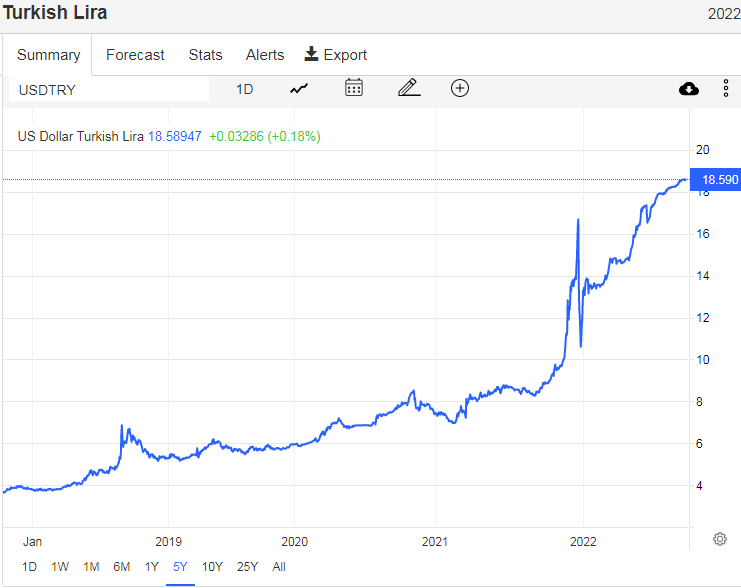
In addition to gold, Turks also imported large quantities of silver during the same period — just over 68,000 kg. The latest figure is nearly double the 36,417 kg imported in September 2021. Besides demanding precious metals, Turks also use digital currencies like bitcoin and the stablecoin tether.
5.OTHER COMMODITIES: COPPER
They say that Copper holds a PhD in Economics. As the economy flourishes so does copper
Here is an in depth look at copper this year.
Miner/OilPrice.com
Copper Remains Range-Bound As Bears And Bulls Duke It Out
TUESDAY, OCT 18, 2022 – 03:30 AM
By Ag Metal Miner via OilPrice.com
The October Copper Monthly Metals Index (MMI) fell 5.59% from September to October, with all components experiencing declines. Still, future copper prices face a wide range of challenges.
Copper prices continue to show signs of short-term consolidation following a brief rebound that stalled in late August. Meanwhile, the bottom found in mid-July and the peak of the subsequent rebound created a short-term trading range for the current sideways trend.

Fed Remains Hawkish, Splits on Rate Hike Pace
Accumulating rate hikes from the Federal Reserve and central banks worldwide added significant weight to copper prices over the past few months. The Fed, in particular, has increased interest rates at the steepest pace in modern history. In September, it issued its third consecutive 75 basis point hike. Even so, Fed officials showed no hesitation in continuing the approach until prices stabilize. That said, officials have started to split on whether to continue on pace or shift to a softer trajectory.
For one, the collective impact of global rate hikes will prove a substantial drag on demand and, therefore, inflation. Indeed, two officials recently voiced the need for restraint going forward. In their opinion, the effect of the Fed’s efforts to date may simply be slow to materialize. In an early October speech, Fed Vice Chairwoman Lael Brainard noted, “it will take time for the cumulative effect of tighter monetary policy to work through the economy and to bring inflation down.” She continued, “the moderation in demand due to monetary-policy tightening is only partly realized so far.”
Experts on The Fence Over the Federal Reserve’s Actions
Mirroring Brainard’s comments, Chicago Fed President Charles Evans warned of the risks associated with “overshooting” the Fed’s goal. Evans noted that between limited inflation reports and the Fed’s actions to date, “puts us at somewhat greater risk of responding overly aggressive.”
Other officials appear far less concerned about the Fed’s aggressive tactics. In response to the current level of inflation, Governor Christopher Waller commented, “this is not the inflation outcome I am looking for to support a slower pace of rate hikes or a lower terminal policy rate.” Beyond that, a still robust labor market will likely outweigh the concerns of more cautious officials. Although growth eased from the previous month, the Labor Department reported that the U.S. added 263,000 jobs in September. This total proved larger than expected, contradicting the Fed’s goal to cool labor demand.
Supply Constraints, Chinese Demand Add Counterweight
As the Fed pressures demand, several factors have added a bullish counterweight. For one, Chinese copper demand remains strong, holding copper prices up. In fact, refined copper imports through August saw a 9.8% year-over-year rise. This is primarily due to heavy increases throughout the summer months. Meanwhile, infrastructure spending, specifically on renewable energy projects, helped lift demand after the Q1 slump.
Secondly, copper production in South America remains pressured. For example, Peruvian copper production fell 1.5% in August, according to the Ministry of Energy and Mines (MINEM). Meanwhile, production in Chile fell even more drastically. According to Cochilco, total Chilean output in August dropped 10.2% from 2021. Both Peru and Chile have faced numerous mining disruptions throughout the year, including protests and reduced mining activity.

LME Actions Could Impact Copper Prices
Copper deliveries face new and potential restrictions from the LME. Indeed, the most recent announcement added significant upward pressure to copper prices. First, the LME announced the immediate restriction of new metal (including copper) from Russia’s Ural Mining & Metallurgical (UMMC). Therefore, any new material delivered to the LME must be proven not to breach the UK’s sanctions against the company’s co-founder, Iskandar Makhmudov.
Separately, the LME requested member input regarding a total ban on Russian metal. The statement noted, “the LME believes it is appropriate, in the absence of general sanctions against Russian metal brands, to seek market views on the expected accessibility of Russian metal in 2023.” While these actions could challenge historically low warehouse inventories, stocks have nonetheless continued to grow since early September. Beyond that, inventory levels do not necessarily impact copper prices. As of 2011, the two continue to display a low inverse correlation of just 17%.
Overall Impacts on Copper Prices
For copper prices, widespread monetary tightening will continue to squeeze long-term demand. Despite the internal division, the Federal Reserve continues to dampen any hopes of a dovish pivot. Indeed, so far, no officials have gone on record to call for a rate hike pause. At this point, most investors expect another 75 basis point rate hike come November.
For now, supply-side constraints and strong Chinese demand have proven enough to halt the macro downtrend. Current copper prices appear resistant to creating either a higher high or lower low. Instead, they continue to move sideways within a tight range.
end
COMMODITIES IN GENERAL/
END
END
6.CRYPTOCURRENCIES
7. GOLD/ TRADING
Your early currency/gold and silver pricing/Asian and European bourse movements/ and interest rate settings TUESDAY morning 7:30 AM
ONSHORE YUAN: CLOSED UP 7.1993
OFFSHORE YUAN: 7.2085
SHANGHAI CLOSED DOWN 3.98 PTS OR 0.13%
HANG SENG CLOSED UP 301.68 OR 1.82%
2. Nikkei closed UP 301.68 PTS OR 1.82%
3. Europe stocks SO FAR: ALL GREEN
USA dollar INDEX DOWN TO 112.13/Euro FALLS TO 0.98339
3b Japan 10 YR bond yield: RISES TO. +.249/ !!!!(Japan buying 100% of bond issuance)/Japanese yen vs usa cross now at 149.10/JAPANESE YEN COLLAPSING AS WELL AS LONG TERM YIELDS RISING BREAKING THE JAPANESE CENTRAL BANK.
3c Nikkei now ABOVE 17,000
3d USA/Yen rate now well ABOVE the important 120 barrier this morning
3e Gold UP /JAPANESE Yen DOWN CHINESE YUAN: UP -// OFF- SHORE: UP
3f Japan is to buy the equivalent of 108 billion uSA dollars worth of bond per month or $1.3 trillion. Japan’s GDP equals 5 trillion usa./“HELICOPTER MONEY” OFF THE TABLE FOR NOW /REVERSE OPERATION TWIST ON THE BONDS: PURCHASE OF LONG BONDS AND SELLING THE SHORT END
Japan to buy 100% of all new Japanese debt and by 2018 they will have 25% of all Japanese debt. EIGHTY percent of Japanese budget financed with debt.
3g Oil DOWN for WTI and DOWN FOR Brent this morning
3h European bond buying continues to push yields lower on all fronts in the EMU. German 10yr bund UP TO +2.252%***/Italian 10 Yr bond yield RISES to 4.698%*** /SPAIN 10 YR BOND YIELD RISES TO 3.429%…** DANGEROUS//
3i Greek 10 year bond yield RISES TO 4.966//
3j Gold at $1652.85//silver at: 18.79 7 am est) SILVER NEXT RESISTANCE LEVEL AT $30.00
3k USA vs Russian rouble;// Russian rouble UP 0 AND 15/100 roubles/dollar; ROUBLE AT 61.69//
3m oil into the 85 dollar handle for WTI and 91 handle for Brent/
3n Higher foreign deposits out of China sees huge risk of outflows and a currency depreciation. This can spell financial disaster for the rest of the world/
JAPAN ON JAN 29.2016 INITIATES NIRP. THIS MORNING THEY SIGNAL THEY MAY END NIRP. TODAY THE USA/YEN TRADES TO 149.10DESTROYING JAPANESE CITIZENS WITH HIGHER FOOD INFLATION
30 SNB (Swiss National Bank) still intervening again in the markets driving down the FRANC. It is not working: USA/SF this 1.0022– as the Swiss Franc is still rising against most currencies. Euro vs SF 0.9757well above the floor set by the Swiss Finance Minister. Thomas Jordan, chief of the Swiss National Bank continues to purchase euros trying to lower value of the Swiss Franc.
USA 10 YR BOND YIELD: 3.998% DOWN 2 BASIS PTS…GETTING DANGEROUS
USA 30 YR BOND YIELD: 4.030% UP 2 BASIS PTS//(USA 30 YR INVERTED TO THE USA 10)
USA DOLLAR VS TURKISH LIRA: 18,59…GETTTING DANGEROUS
GREAT BRITAIN/10 YEAR YIELD: 4.05%
end
Overnight: Newsquawk and Zero hedge:
FIRST, ZEROHEDGE
Futures Soar Despite Latest UK Newsflow Rollercoaster Fiasco
TUESDAY, OCT 18, 2022 – 08:00 AM
It was another overnight emotional and markets rollercoaster session thanks to the constant chaos of newsflow and confusion out of the UK.
Just around midnight ET, the Financial Times reported that the Bank of England would delay the start of its gilt-sale program (i.e. Q.T.), sending UK gilts, sterling and US equity futures sharply higher. Those gains, however, turned to losses when the central bank denied the report in a statement just around 5am ET, pushing the yield on the UK 10-year bond seven basis points higher to 4.05% while cable dumped 0.5%. That said, the BOE didn’t rule out the prospect of the BOE announcing a delay at a later time. The central bank has already delayed the start of the sales once, during the fallout from the government’s fiscal plan last month
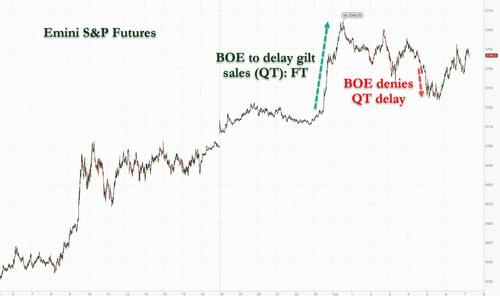
Despite the reversal by the BOE, the huge meltup which we said would be triggered on Monday by Friday’s massive shorting, extended for a second day, encouraged by the reversal of uber-bear Michael Wilson who as we noted yesterday, expects a bear market rally pushing the S&P as high as 4,150, and helping the S&P to close above a key technical level on Monday. Nasdaq 100 futures rose 1.8%, while S&P 500 futures advanced 1.6% at 7:30 a.m. in New York, as tech giants Amazon and Microsoft led major technology and internet stocks higher in premarket trading, while the 10-year Treasury yield holds steady at about 4% and the Bloomberg dollar index was flat.
In premarket trading, bank stocks traded higher as Goldman Sachs becomes the last of the big six US lenders to report earnings this quarter, beating on the top and bottom line (a more detailed report to follow). In corporate news, Credit Suisse is exploring a sale of its US asset-management operations and moving closer to securing financing for other businesses. Amazon and Microsoft lead major US technology and internet stocks higher in premarket trading, set to extend their gains for a second straight session. Nvidia (NVDA US) +2.7%, Amazon (AMZN US) +2.3%, Alphabet (GOOGL US) +2%, Meta (META US) +2%, Apple (AAPL US) +1.7% and Microsoft (MSFT US) +1.7%. Here are some other premarket movers:
- AVEO (AVEO US) shares jump 38% in US premarket trading hours to $14.43 after LG Chem said it will buy the biotech for $15 per share in an all-cash transaction with an implied equity value of $566m on a fully diluted basis.
- Target (TGT US) stock rises 2.7% in US premarket trading after it was upgraded to buy from hold at Jefferies, which says the combination of a subdued valuation and improvements in the supply chain and inventory positioning supports a bullish stance on the retailer.
- FuboTV (FUBO US) shares rise as much as 11% in premarket trading, with analysts saying the firm’s decision to end operations of its Fubo Sportsbook betting unit will help its bottom line.
- Juniper (JNPR US) shares gain as much as 2.6% in US premarket trading after Piper Sandler upgraded the internet infrastructure company to neutral from underweight with the expectation that management can continue to increase product revenue numbers in full-year 2023 by around 10% year-on-year.
- Keep an eye on MongoDB (MDB US) after its shares were raised to neutral at Redburn as the stock is trading 20% below 2020 valuation lows and the brokerage sees no further downside that justifies a sell rating.
- Watch US timber stocks as RBC reshuffles ratings in the sector ahead of the third-quarter earnings season, which analysts say will mark a “sharp return” to normalized pricing, while downgrading Resolute (RFP US) and Western Forest Products (WEF CN) to sector perform from outperform.
“Investors keep pushing stock indices higher following the rebound over the annual lows at the end of last week, and growing risk appetite can now be seen across different asset classes,” said Pierre Veyret, a technical analyst at ActivTrades. As risks including high inflation, slower growth and the energy crisis still remain, “this is still seen as a technical correction,” he added.
Another reason for the continued meltup is because JPMorgan’s inhouse permabull, Marko Kolanovic, who has been long and wrong all year, appears to have thrown in the towel and late on Monday the Croat trimmed the extent of equities overweight in his model portfolio this month, citing “increasing risks around central banks making a hawkish policy error and geopolitics.” As we have said before, the bear market won’t end until Marko turns bearish, so that was another piece of the puzzle falling into place.
Meanwhile, the Bank of America monthly global fund manager survey “screams macro capitulation, investor capitulation, start of policy capitulation,” opening the way to an equities rally in 2023 the bank’s Chief Investment Strategist, Michael Hartnett wrote in a note on Tuesday. They expect stocks to bottom in the first half of 2023 after the Federal Reserve pivots away from raising interest rates.
“There’s still a strong feeling of a bear market rally about trading over the course of the last week,” said Craig Erlam, senior market analyst at Oanda Europe Ltd. “The economic landscape looks treacherous and we don’t even know if we’re at peak inflation and interest rate pricing yet. Those are substantial headwinds that will make any stock market rebound extremely challenging.”
In Europe, stocks rose for a fourth day, with most industry groups in the green. Risk sentiment was firmly bullish, with cyclical stocks leading the rally, while technology shares also outperformed. Autos, tech and financial services lead gains in Europe as Euro Stoxx 50 rallies 1.4%. FTSE MIB outperforms peers, adding 1.8%. Here are the most notable European movers:
- AZA SS: Avanza shares jump as much as 17%, the most since Oct. 2019, after the Swedish retail trading and savings platform reported what Handelsbanken called a “strong beat” on net interest income.
- THG LN: THG shares surge as much as 12% after SoftBank sold its stake in the British online shopping firm. The sale removes an overhang on the stock and it could help sentiment that existing investor Qatar Investment Authority bought the majority of the stake, according to Bloomberg Intelligence analysts.
- TIT IM: Telecom Italia shares rise as much as 9.6% in Milan trading on speculation reported by Italian newspaper MF regarding potential interest for the company by CVC.
- PUB FP: Publicis shares rise as much as 4.7% after the advertising agency lifted FY organic growth guidance for a second straight quarter.
- GALP PL: Portuguese oil co. Galp falls as much as 6.8% as it says it received a force majeure notice from Nigeria LNG following flooding that caused a “substantial reduction” in the production and supply of LNG and natural gas liquids, according to a regulatory filing.
- N91 LN: Ninety One shares drop as much as 5.3% after the investment manager reported a decline in assets under management during the second quarter.
- ERF FP: Eurofins Scientific shares drop as much as 6.0%, the most since July 28, after the provider of testing services reported third-quarter revenue that fell year-on-year.
- ROG SW: Roche shares slide as much as 1.6% after the Swiss pharmaceutical group slightly missed consensus 3Q expectations on overall sales, but focus remains on its outlook and pipeline, analysts say.
Earlier in the session, Asian equities rebounded, led by advances in tech stocks following a rally on Wall Street, as possible delays in bond sales by the Bank of England bolstered investor sentiment. The MSCI Asia Pacific Index rose as much as 1.5%, buoyed by TSMC, Tencent and Alibaba. All sub-gauges except real estate climbed. The Financial Times reported that the BoE may delay selling billions of pounds of government bonds, easing investor angst after the UK’s botched fiscal plan. The UK central bank denied the report after most markets in the region were closed. Tech stocks listed in Hong Kong climbed after the Nasdaq 100 index had its best day since July. Most benchmarks advanced, with notable gains in Australia, Japan, Hong Kong, and South Korea. Concerns that China is delaying the release of its 3Q GDP report amid the on-going party congress failed to quell the mood. The prospect of the BoE postponing QT “offers the potential for a decline in global rates volatility, a pre-condition for a broader improvement in cross-asset risk sentiment,” Stephen Innes, managing partner at SPI Asset Management, said before the bank’s denial. It’s been almost a year since Bitcoin hit a record. Even after Tuesday’s gain, the key Asian stock benchmark still trades close to its early-2020 low, as China’s virus lockdowns and property crisis weigh on growth. Asian stocks have underperformed their US and European peers this year as the Fed’s rate hikes pressure emerging market currencies, triggering an exodus of foreign funds
Japanese stocks rose, following a rebound in US peers as the S&P 500 was seen pointing toward a technical recovery. Electronics makers were the biggest boost. The Topix rose 1.2% to close at 1,901.44, while the Nikkei advanced 1.4% to 27,156.14. Recruit Holdings Co. contributed the most to the Topix gain, rising 5.1% after announcing a buyback. Out of 2,166 stocks in the index, 1,809 rose and 279 fell, while 78 were unchanged.
Australia stocks rebounded with tech and real estate shares leading; the S&P/ASX 200 index rose 1.7% to close at 6,779.20. The climb tracks a regional rally, buoyed after gains on Wall Street and a report of a possible delay in the Bank of England’s quantitative tightening. In New Zealand, the S&P/NZX 50 index rose 0.6% to 10,847.34.
In rates, Treasuries edged higher in early US trading after paring declines. Losses persist in gilts, where UK curve bear-flattens, with bunds also under pressure amid auctions by Germany, UK and Finland. US yields remain within 2bp of Monday’s closing levels, 10-year yields just under 4% with bunds and gilts trading cheaper by 6bp and 8bp in the sector. Gilt price action has been choppy; Long-end gilts take a breather, 10-year yield about 1bp higher after FT reported that Bank of England is set to delay quantitative tightening until gilt markets calm which the BOE later denied; UK sells 30-year notes later.
In FX, the Bloomberg Dollar Spot Index pared losses to trade marginally lower; yen settles at around the 149 handle while the pound trades lower toward $1.13.
- New Zealand’s dollar led G-10 gains after quarter-on-quarter inflation exceeded forecasts, fueling bets the central bank will need to keep raising interest rates
- The euro moved in a narrow range around $0.950, while the German 10- year yield reversed earlier losses to gain 6bps to 2.32%
- The pound weakened against all of its G-10 peers and fell below $1.13, following in an advance of as much as 0.5% to $1.1410. The long-term outlook for the pound has started to improve. At least, that’s what the options market is saying.
- The yen briefly rallied sharply versus the dollar after dropping to 149.29 per dollar, the lowest level since August 1990. Bank of Japan Governor Haruhiko Kuroda said that while the interest-rate differential with US has been a driving factor for the yen to weaken recently, the currency doesn’t move in parallel with the difference over the longer term
- The yuan stayed near 7.2 per dollar as the central bank kept the currency’s reference rate near 7.1 level in the last few sessions, a move that’s expected to slow the currency’s decline. USD/CNY falls 0.1% to 7.2000. It droped as much as 1.2% in early trade, close to the central bank’s fixing. USD/CNH little changed at 7.2075.
In commodities, oil switched between gains and losses as traders weighed a tight market against concerns over a global economic slowdown. WTI and Brent December contracts are softer on the session and gave up earlier gains as the DXY creeps higher throughout the European morning. Spot gold is flat around the USD 1,650/oz mark in a USD 10/oz range – but still under its 10 and 21 DMAs at 1,673.56/oz and 1,668.63/oz. LME metals are mostly lower amid the recent rise of the Dollar, whilst Rio Tinto forecasted annual iron ore shipments at the lower end of guidance and sees further downside risks to demand as the global economy slows. White House is reportedly planning an oil reserve release announcement this week with a release of another 10mln-15mln bbls in an effort to balance markets and keep prices from climbing, according to Bloomberg.
EU financial services chief McGuiness called on the US to create new crypto rules and said any regulation imposed on the industry would need to be global for it to work, according to FT.
Looking to the day ahead now, and data releases from the US include industrial production and capacity utilisation for September, as well as the NAHB housing market index for October. Central bank speakers include the ECB’s Makhlouf and Schnabel, as well as the Fed’s Bostic and Kashkari. Finally, earnings releases include Goldman Sachs, Netflix, Johnson & Johnson, and Lockheed Martin.
Market Snapshot
- S&P 500 futures up 1.4% to 3,741.00
- MXAP up 1.4% to 138.93
- MXAPJ up 1.6% to 450.98
- Nikkei up 1.4% to 27,156.14
- Topix up 1.2% to 1,901.44
- Hang Seng Index up 1.8% to 16,914.58
- Shanghai Composite down 0.1% to 3,080.96
- Sensex up 1.0% to 58,966.61
- Australia S&P/ASX 200 up 1.7% to 6,779.22
- Kospi up 1.4% to 2,249.95
- STOXX Europe 600 up 1.1% to 402.75
- German 10Y yield up 3% at 2.337%
- Euro up 0.1% to $0.9852
- Brent Futures down 0.6% to $91.05/bbl
- Gold spot up 0.1% to $1,651.42
- U.S. Dollar Index up 0.1% at 112.187
Top Overnight News from Bloomberg
- Just 10% of Britons have a favorable opinion of Liz Truss, a YouGov survey found, piling further woes on the beleaguered prime minister a day after she was forced to row back on the bulk of her economic vision for Britain
- UK trade unions have called on millions of workers to protest against any return to austerity after Britain’s new chancellor of the Exchequer warned that “some areas of spending will need to be cut.”
- There’s scope for a Polish central bank hike by as much as 100bps in November, Monetary Policy Council member Joanna Tyrowicz says in ISB News interview
- French rail, energy and other key workers are striking on Tuesday to demand a bigger share of corporate profits, raising pressure on President Emmanuel Macron to take further steps to ease the impact of surging inflation
- ECB policy maker François Villeroy de Galhau expects the central bank to continue to “go quickly” until its deposit rate reaches 2% at the end of the year, Financial Times reports, citing an interview
A more detailed look at global markets courtesy of Newsquawk
Asia-Pac stocks were positive with the region inspired by gains in global counterparts following the UK Chancellor’s reversal of most of the measures of the ‘mini-Budget’ and with a report later suggesting a delay of QT by the BoE. ASX 200 was led by strength in tech and with the top-weighted financials sector also notching firm gains, while commodity-related stocks were somewhat varied with Rio Tinto choppy after a mixed quarterly activity report. Nikkei 225 reclaimed the 27,000 level to the upside, but was off highs with officials continuing to pledge to take action to address excess FX moves. Hang Seng and Shanghai Comp. gained although the mainland lagged amid COVID woes after Nanjing halted certain indoor venues due to rising cases, while the postponement of key Chinese data releases including Q3 GDP has led to some speculation that the data could be disappointing, although it was also suggested that the delay could be so that officials can concentrate on the Chinese Communist Party Congress.
Top Asian News
- China’s Nanjing halted certain indoor venues including bars, KTVs and gyms, while it also halted dine-in services due to an increase in coronavirus cases.
- RBA Minutes from the October 4th Meeting stated the decision to raise rates by only 25bps was finely balanced with the smaller move warranted by the scale of hikes already delivered and lags in policy. RBA added that the uncertain outlook argued for slower hikes for a time but noted further increases in rates are likely over the period ahead and that rates are not especially high, while the board emphasised the importance of keeping inflation expectations anchored and RBA said monthly CPI data confirmed broad-based pick-up in inflation, rents and utilities are expected to increase.
- RBA Deputy Governor Bullock said the board expects to increase interest rates further over the coming months with the pace and timing to be determined by data, while she added that as the board meets more frequently than most peers, it can achieve a similar tightening with smaller individual rate increases.
European equity bourses traded with gains across the board but are off best levels. Sectors are mostly firmer with no overarching theme; Autos & Parts, Financial Services, and Industrial Goods lead the charge whilst Healthcare, Optimised Personal Care, Energy and Basic Resources sit at the bottom of the pile. US equity futures are firmer to a greater magnitude than their European counterparts, with the ES trading on either side of 3,750 whilst the NQ outperforms its peers. Intel’s (INTC) MobilEye IPO is set to be priced between USD 18-20/shr, according to Bloomberg. Renault (RNO FP) and Nissan (7201 JT) are moving towards a “landmark” deal to reshape their alliance, according to Bloomberg; subsequently echoed by the Renault CEO in a Nikkei interview.
Top European News
- BoE is reportedly expected to further delay quantitative tightening until gilt markets calm, according to FT. Subsequently, the BoE labelled this report as “inaccurate”.
- UK PM Truss said she wants to accept responsibility and apologise for the mistakes made, while she added that she will lead the Tories into the next general election and is sticking around because she was elected to deliver for the country. PM Truss also stated the most vulnerable will be protected into next winter regarding household energy bills and that they are looking at exactly how they can do that, according to a BBC interview.
- ECB’s Villeroy said the UK crisis shows the risk of a vicious loop and that the pensions turmoil underscored the need for non-banks to build liquidity buffers, according to FT.
- European Commission to unveil proposal of further emergency energy measures for coming winter (including joint purchasing & alternative benchmark) at 14:30BST/09:30EDT, according to journalist Keating.
FX
- Kiwi elevated as stronger than expected NZ CPI metrics lift RBNZ rate outlooks, NZD/USD probes 0.5700 before pullback
- Sterling underperforming after making stellar gains on Monday as BoE says FT’s QT delay report is inaccurate; Cable sub-1.1300 from just over 1.1400 at one stage
- Loonie lags within a 1.3771-1.3657 range as crude prices sag
- Euro pivots 0.9850 vs Buck as DXY holds around 112.000 and Fib resistance at 0.9858 hampers EUR/USD
- Yen pares some losses from under 149.00 against Dollar amidst some unsubstantiated talk of intervention
- The CBRT’s move to raise the required level of bond holdings for FX deposits means that banks must hold an additional TRY 80-100bln of bonds, via Reuters citing bankers.
- BoJ and FSA are to hold 17th cooperation on financial stability, according to reports.
Fixed Income
- Gilts saw an initial bounce at the open on overnight FT reporting around a potential delay to QT; however, this was modest in nature and has since given way to marked pressure following BoE labelling it as “inaccurate”.
- The overall complex is pressured, with Gilts lagging though Bunds are in close proximity and below 136.00 post poor 7yr-supply and ahead of ECB speak.
- Stateside, UTS have been following their peers directionally though magnitudes are more contained overall pre-data/Fed speak; yield curve mixed, overall.
Commodities
- WTI and Brent December contracts are softer on the session and gave up earlier gains as the DXY creeps higher throughout the European morning.
- Spot gold is flat around the USD 1,650/oz mark in a USD 10/oz range – but still under its 10 and 21 DMAs at 1,673.56/oz and 1,668.63/oz.
- LME metals are mostly lower amid the recent rise of the Dollar, whilst Rio Tinto forecasted annual iron ore shipments at the lower end of guidance and sees further downside risks to demand as the global economy slows.
- White House is reportedly planning an oil reserve release announcement this week with a release of another 10mln-15mln bbls in an effort to balance markets and keep prices from climbing, according to Bloomberg. Note, this would come from part of a previously announced 180mln bbl sale announced earlier in the year
- UAE supports Saudi Foreign Ministry’s statement regarding the OPEC+ decision and fully stands with Saudi Arabia in its efforts to support energy stability and security, according to the state news agency cited by Reuters.
Geopolitics
- US Commerce Department issued a temporary denial order against Ural Airlines for operating in apparent violation of US export controls on Russia, according to Reuters.
- Ukraine President Zelenskiy says there is no space left for negotiations with Russian President Putin, via Reuters.
- Russia’s Kremlin, when asked if Russia’s nuclear umbrella extends to annexed territories, says all the territories are parts of Russia and their security is provided as with all other Russian territories, via Reuters.
- Japanese Chief Cabinet Secretary Matsuno said Japan is to impose additional sanctions against North Korea, according to Reuters.
- Officials revealed that China recruited dozens of former British military pilots to teach Chinese armed forces how to defeat western warplanes and helicopters in a “threat to UK interests”, according to Sky News’s Deborah Haynes.
US Event Calendar
- 09:15: Sept. Capacity Utilization, est. 80.0%, prior 80.0%
- 09:15: Sept. Manufacturing (SIC) Production, est. 0.2%, prior 0.1%
- 09:15: Sept. Industrial Production MoM, est. 0.1%, prior -0.2%
- 10:00: Oct. NAHB Housing Market Index, est. 43, prior 46
- 16:00: Aug. Total Net TIC Flows, prior $153.5b
- 16:00: Aug. Net Foreign Security Purchases, prior $21.4b
Central bank speakers
- 14:00: Fed’s Bostic Takes Part in Workrise Panel Discussion
- 17:30: Fed’s Kashkari Discusses the Economy
DB’s Jim Reid concludes the overnight wrap
We’ve discussed recently how we shouldn’t underestimate just how much the UK’s recent woes have impacted global markets. Correlation doesn’t equal causality, but the UK news has again seemed to heavily influence global markets over the last 24 hours after the UK government officially announced one of the biggest U-turns in political history and ditched the bulk of what remained of their mini-budget. However the risk momentum was also helped by a view that earnings season has starting relatively well versus beaten up expectations. Even overnight the UK is moving global markets again as reports from the FT that the BoE is going to delay QT at around 5am this morning have pushed equities futures over a percent higher with S&P 500 (+1.95%) and NASDAQ 100 (+2.17%) contracts soaring.
This follows a big session yesterday with the S&P 500 (+2.65%) and the STOXX 600 (+1.83%) both posting strong advances that were led by the more cyclical sectors. Tech stocks were one of the big outperformers, with the NASDAQ (+3.43%) and the FANG+ Index (+4.83%) seeing even stronger advances, whilst banks were another outperformer with those in the S&P 500 up +3.48% in their 4th consecutive advance. The moves were also supported by some positive corporate news, with Lufthansa raising their full-year forecasts whilst Bank of America saw trading revenue beat expectations and net interest income rise to a record in Q3, a common theme among banks benefitting from heightened market volatility and rising policy rates. Bank of America joins the other large US banks to report with JPMorgan (+5.94% since releasing earnings), Citi (+1.44% since), Wells Fargo (+3.68%), and Morgan Stanley (-2.75%) all having reported the last few days. That comes as earnings season is moving into full flow, with today’s releases including Netflix, Goldman Sachs and Johnson & Johnson. We’ve had 38 S&P companies report so far, and while major financials have grabbed a lot of the headlines there have been a number of key corporate reporters including consumer staples Walgreens (+3.32% since their earnings), health care provider United Health Group (+2.38% since reporting), food and beverage retailer PepsiCo (+6.24% since reporting), and airline Delta (+6.61%). The breadth of reporters should expand with the major US banks largely now in the rear-view mirror.
Back to the UK and there was an increasing sense of what was coming yesterday, with the first reversal happening two weeks ago as they U-turned on the abolition of the top 45% rate of income tax. Then on Friday we had a second reversal as PM Truss announced that corporation tax would go up after all, in line with the previous government’s plans. But yesterday saw Chancellor Hunt announce that almost everything else would be going as well, including the planned cut in the basic rate of income tax to 19% from April 2023, which will instead be kept at 20% indefinitely.
It’s clear the UK are now desperately trying to claw back their market credibility, as not only have the government reversed course on most of the tax cuts, but they also said they’d revisit the scale of their energy support package as well. Previously, energy prices were set to be capped at £2,500 per year for the average household over the next two years. But the government are now saying that will only go up until April 2023, and after that they’d review what support would be given instead, and were aiming to “design a new approach that will cost the taxpayer significantly less than planned”. Furthermore, the government’s statement implied there was more to come in the fiscal statement on October 31, as it said that government departments “will be asked to find efficiencies within their existing budgets”, and that there’d be “further changes” on fiscal policy “to put the public finances on a sustainable footing”.
UK assets surged on the back of the announcements, with sterling +1.66% higher versus the US dollar after having been as much as +2.38% up, just as yields on 10yr UK gilts tumbled by -35.7bps to 3.96%. In fact, apart from September 28 when the Bank of England began their intervention, that’s the largest daily decline in the 10yr gilt yield since the Conservatives won a surprise victory in the 1992 general election, so we are still experiencing unprecedented volatility. Meanwhile, sterling (+0.31%) is trading higher again this morning ($1.1393) on the FT story that QT is set to be delayed. Back to yesterday and the declines in real yields were even more pronounced than nominals, with the 10yr real yield down by -47.9bps on the day, which again is the largest daily move since the BoE intervention began. That said, even with the recent declines, the spread of UK 10yr yields over German bunds is still wider than it was prior to the mini-budget at +169bps, which points to the fact that investors are still charging a larger premium for holding gilts, even with the recent U-turns.
Sovereign bonds rallied with Gilts in Europe, with yields on 10yr bunds (-7.7bps), OATs (-8.8bps) and BTPs (-13.3bps) all moving lower on the day. Those declines were seen across maturities, and came as we also had a further decline in both US and European natural gas futures that left both at their lowest levels since the summer. In Europe, they were down by a further -13.26% yesterday, which leaves them at a 4-month low of €123 per megawatt-hour, with mild weather supporting storage levels.
Treasury yields initially rallied in lock step with European yields, reaching a rally of -11.1bps shortly after the New York open. Once Europe called it a day, however, yields steadily marched higher to close the day roughly unchanged (-0.6bps) and back above 4%. There wasn’t any specific catalyst of higher 10yr yields, other than perhaps US-based investors are more focused on the Fed and inflation outlook than on UK financial instability. The strength in US equities throughout the day probably also contributed to a stronger growth perception in the US, driving the +4.3bps steepening in 2s10s that we saw today. This morning in Asia, the UK is back influencing Treasuries as 10yr UST yields have gone from flattish to around -4.5bps lower after the FT BoE headlines.
Asian stock markets are also higher with the Nikkei (+1.52%), the Hang Seng (+1.61%), Kospi (+0.99%) stronger still on the FT/BoE headlines. Elsewhere, Chinese shares are lagging with the Shanghai Composite (+0.17%) and the CSI (+0.08%) edging up after declining earlier.
We were meant to get the Q3 GDP release and a slew of other economic data from China overnight, but we found out yesterday that it was being delayed. The unusual move comes as the ruling Communist Party is holding its twice-a-decade event i.e., 20th National Congress. So far, no date for a rescheduled release has been given.
Minutes from the Reserve Bank of Australia’s (RBA) October meeting revealed that the central bank’s surprise decision to ease back to a 25bps hike instead of the 50bps hikes was “finely balanced” as the board members wanted to monitor the impact of its tightening on household spending in an uncertain environment. The minutes also highlighted that further rate hikes are likely required over the period ahead with the pace and timing to be determined by data. Elsewhere, New Zealand’s consumer prices rose +7.2% y/y in the third quarter, much higher than the market expected +6.6% increase, thus cementing the prospect of further aggressive hikes by the Reserve Bank of New Zealand (RBNZ).
In spite of the positive market moves over the last 24 hours, there was further bad news on the DM data side, with the New York Fed’s Empire index showing a third consecutive monthly contraction at -9.1 (vs. -4.3 expected). The prices paid index also ticked up relative to last month, reaching 48.6. Meanwhile in Canada, data from the central bank showed that inflation expectations over 1 and 2 years ahead were continuing to rise, although 5-year ahead expectations moved lower. That came as their business outlook indicator in Q3 fell to 1.69, which is the biggest quarterly decline in that indicator since Q2 2020 as the pandemic’s impact was fully felt.
To the day ahead now, and data releases from the US include industrial production and capacity utilisation for September, as well as the NAHB housing market index for October. Over in Europe, there’s also the German ZEW survey for October. Central bank speakers include the ECB’s Makhlouf and Schnabel, as well as the Fed’s Bostic and Kashkari. Finally, earnings releases include Goldman Sachs, Netflix, Johnson & Johnson, and Lockheed Martin.
AND NOW NEWSQUAWK
Gilts & GBP pressured as the BoE pushed back on the FT’s QT delay report – Newsquawk US Market Open

TUESDAY, OCT 18, 2022 – 06:34 AM
- Equity bourses in Europe trade with gains across the board but are off best levels; US futures are faring better
- NZD leads after strong CPI while GBP lags as the BoE pushes back on QT delay reports, DXY firmer but off best
- Yen pares some losses from under 149.00 against the Dollar amidst some unsubstantiated talk of intervention
- Overall fixed complex is pressured, with Gilts lagging though Bunds are in close proximity and below 136.00 post poor 7yr-supply and ahead of ECB speak.
- WTI and Brent December contracts are softer on the session and gave up earlier gains as the DXY creeps higher
- Looking ahead, highlights include US Industrial Production & Capacity Utilisation, Speeches from Fed’s Bostic, Kashkari & ECB’s Schnabel. Earnings from Goldman Sachs, JNJ, LMT, Netflix, United Airlines, Interactive Brokers.

As of 11:05BST/06:05ET
View the full premarket movers and news report.
Or why not try Newsquawk’s squawk box free for 7 days?
LOOKING AHEAD
- Looking ahead, highlights include US Industrial Production & Capacity Utilisation, Speeches from Fed’s Bostic, Kashkari & ECB’s Schnabel. Earnings from Goldman Sachs, JNJ, LMT, Netflix, United Airlines, Interactive Brokers.
- Click here for the Week Ahead preview.
EUROPEAN TRADE
EQUITIES
- Equity bourses in Europe trade with gains across the board but are off best levels.
- Sectors are mostly firmer with no overarching theme; Autos & Parts, Financial Services, and Industrial Goods lead the charge whilst Healthcare, Optimised Personal Care, Energy and Basic Resources sit at the bottom of the pile.
- US equity futures are firmer to a greater magnitude than their European counterparts, with the ES trading on either side of 3,750 whilst the NQ outperforms its peers.
- Intel’s (INTC) MobilEye IPO is set to be priced between USD 18-20/shr, according to Bloomberg.
- Renault (RNO FP) and Nissan (7201 JT) are moving towards a “landmark” deal to reshape their alliance, according to Bloomberg; subsequently echoed by the Renault CEO in a Nikkei interview.
- Click here for more detail.
FX
- Kiwi elevated as stronger than expected NZ CPI metrics lift RBNZ rate outlooks, NZD/USD probes 0.5700 before pullback
- Sterling underperforming after making stellar gains on Monday as BoE says FT’s QT delay report is inaccurate; Cable sub-1.1300 from just over 1.1400 at one stage
- Loonie lags within a 1.3771-1.3657 range as crude prices sag
- Euro pivots 0.9850 vs Buck as DXY holds around 112.000 and Fib resistance at 0.9858 hampers EUR/USD
- Yen pares some losses from under 149.00 against Dollar amidst some unsubstantiated talk of intervention
- The CBRT’s move to raise the required level of bond holdings for FX deposits means that banks must hold an additional TRY 80-100bln of bonds, via Reuters citing bankers.
- BoJ and FSA are to hold 17th cooperation on financial stability, according to reports.
- Click here for more detail.
FIXED INCOME
- Gilts saw an initial bounce at the open on overnight FT reporting around a potential delay to QT; however, this was modest in nature and has since given way to marked pressure following BoE labelling it as “inaccurate”.
- The overall complex is pressured, with Gilts lagging though Bunds are in close proximity and below 136.00 post poor 7yr-supply and ahead of ECB speak.
- Stateside, UTS have been following their peers directionally though magnitudes are more contained overall pre-data/Fed speak; yield curve mixed, overall.
- Click here for more detail.
COMMODITIES
- WTI and Brent December contracts are softer on the session and gave up earlier gains as the DXY creeps higher throughout the European morning.
- Spot gold is flat around the USD 1,650/oz mark in a USD 10/oz range – but still under its 10 and 21 DMAs at 1,673.56/oz and 1,668.63/oz.
- LME metals are mostly lower amid the recent rise of the Dollar, whilst Rio Tinto forecasted annual iron ore shipments at the lower end of guidance and sees further downside risks to demand as the global economy slows.
- White House is reportedly planning an oil reserve release announcement this week with a release of another 10mln-15mln bbls in an effort to balance markets and keep prices from climbing, according to Bloomberg. Note, this would come from part of a previously announced 180mln bbl sale announced earlier in the year
- UAE supports Saudi Foreign Ministry’s statement regarding the OPEC+ decision and fully stands with Saudi Arabia in its efforts to support energy stability and security, according to the state news agency cited by Reuters.
- Click here for more detail.
NOTABLE EUROPEAN HEADLINES
- BoE is reportedly expected to further delay quantitative tightening until gilt markets calm, according to FT. Subsequently, the BoE labelled this report as “inaccurate”.
- UK PM Truss said she wants to accept responsibility and apologise for the mistakes made, while she added that she will lead the Tories into the next general election and is sticking around because she was elected to deliver for the country. PM Truss also stated the most vulnerable will be protected into next winter regarding household energy bills and that they are looking at exactly how they can do that, according to a BBC interview.
- ECB’s Villeroy said the UK crisis shows the risk of a vicious loop and that the pensions turmoil underscored the need for non-banks to build liquidity buffers, according to FT.
- European Commission to unveil proposal of further emergency energy measures for coming winter (including joint purchasing & alternative benchmark) at 14:30BST/09:30EDT, according to journalist Keating.
NOTABLE EUROPEAN DATA
- German ZEW Economic Sentiment (Oct) -59.2 vs. Exp. -65.7 (Prev. -61.9); Current Conditions (Oct) -72.2 vs. Exp. -68.0 (Prev. -60.5)
- Current situation is once again assessed as significantly worse than the prior month; probability that GDP will fall in the course of the next six months has increased considerably.
NOTABLE US HEADLINES
- SGH Macro Advisers says it is their understanding that “that five ministries and commissions under China’s governing State Council are jointly studying countermeasures against the latest round of US chips bans against China”
CRYPTO
- EU financial services chief McGuiness called on the US to create new crypto rules and said any regulation imposed on the industry would need to be global for it to work, according to FT.
GEOPOLITICS
RUSSIA-UKRAINE
- US Commerce Department issued a temporary denial order against Ural Airlines for operating in apparent violation of US export controls on Russia, according to Reuters.
- Ukraine President Zelenskiy says there is no space left for negotiations with Russian President Putin, via Reuters.
- Russia’s Kremlin, when asked if Russia’s nuclear umbrella extends to annexed territories, says all the territories are parts of Russia and their security is provided as with all other Russian territories, via Reuters.
OTHER
- Japanese Chief Cabinet Secretary Matsuno said Japan is to impose additional sanctions against North Korea, according to Reuters.
- Officials revealed that China recruited dozens of former British military pilots to teach Chinese armed forces how to defeat western warplanes and helicopters in a “threat to UK interests”, according to Sky News’s Deborah Haynes.
APAC TRADE
EQUITIES
- APAC stocks were positive with the region inspired by gains in global counterparts following the UK Chancellor’s reversal of most of the measures of the ‘mini-Budget’ and with a report later suggesting a delay of QT by the BoE.
- ASX 200 was led by strength in tech and with the top-weighted financials sector also notching firm gains, while commodity-related stocks were somewhat varied with Rio Tinto choppy after a mixed quarterly activity report.
- Nikkei 225 reclaimed the 27,000 level to the upside, but was off highs with officials continuing to pledge to take action to address excess FX moves.
- Hang Seng and Shanghai Comp. gained although the mainland lagged amid COVID woes after Nanjing halted certain indoor venues due to rising cases, while the postponement of key Chinese data releases including Q3 GDP has led to some speculation that the data could be disappointing, although it was also suggested that the delay could be so that officials can concentrate on the Chinese Communist Party Congress.
NOTABLE APAC HEADLINES
- China’s Nanjing halted certain indoor venues including bars, KTVs and gyms, while it also halted dine-in services due to an increase in coronavirus cases.
- RBA Minutes from the October 4th Meeting stated the decision to raise rates by only 25bps was finely balanced with the smaller move warranted by the scale of hikes already delivered and lags in policy. RBA added that the uncertain outlook argued for slower hikes for a time but noted further increases in rates are likely over the period ahead and that rates are not especially high, while the board emphasised the importance of keeping inflation expectations anchored and RBA said monthly CPI data confirmed broad-based pick-up in inflation, rents and utilities are expected to increase.
- RBA Deputy Governor Bullock said the board expects to increase interest rates further over the coming months with the pace and timing to be determined by data, while she added that as the board meets more frequently than most peers, it can achieve a similar tightening with smaller individual rate increases.
DATA RECAP
- New Zealand CPI QQ (Q3) 2.2% vs. Exp. 1.6% (Prev. 1.7%); YY (Q3) 7.2% vs. Exp. 6.6% (Prev. 7.3%)
- RBNZ Sectoral Factor Model Inflation Index (Q3) 5.4% (Prev. 4.8%)
i)TUESDAY MORNING// MONDAY NIGHT
SHANGHAI CLOSED DOWN 3.98 PTS OR 0.13% //Hang Seng CLOSED UP 301.68 OR 1.82% /The Nikkei closed UP 380.35PTS OR 1.42% //Australia’s all ordinaires CLOSED UP 1.78% /Chinese yuan (ONSHORE) closed UP TO 7.1994 //OFFSHORE CHINESE YUAN UP 7.20985// /Oil DOWN TO 85.56 dollars per barrel for WTI and BRENT AT 91.55 / Stocks in Europe OPENED ALL GREEN. ONSHORE YUAN TRADING ABOVE LEVEL OF OFFSHORE YUAN/ONSHORE YUAN TRADING STRONGER AGAINST US DOLLAR/OFFSHORE STRONGER
2 a./NORTH KOREA/ SOUTH KOREA/
///NORTH KOREA/SOUTH KOREA/
end
2B JAPAN
(COURTESY ZEROHEDGE)
Japanese FX Intervention Fails Again As Yen Plunge Continues
TUESDAY, OCT 18, 2022 – 09:10 AM
The Japanese Yen appears to be inexorably drawn to the Maginot Line of 150/USD as for the third time in less than a month, Japan’s ‘yentervention’ failed overnight.
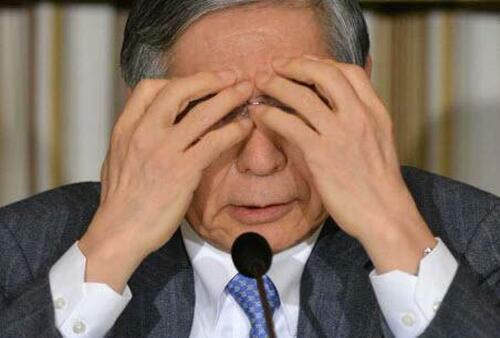
As we detailed before the Asian open last night, Japanese Prime Minister Fumio Kishida stepped up the rhetoric against the weakening yen, daring traders to test him with threats of policy maker willingness to step into markets.
They did test him… and it appears pretty clear than Tokyo stepped in (though not admitted)… and then the yen kept tumbling further…

That is strike 3 for yentervention.
Strike 2 was just last week…
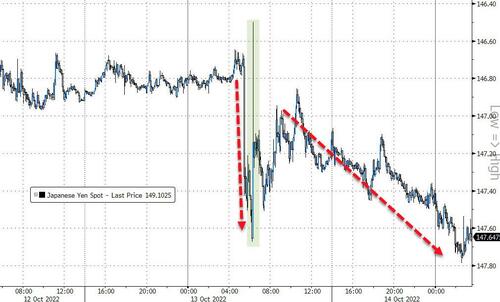
And Strike 1 was on September 22…

“If dollar-yen rises past the symbolic 150 level, price action will naturally accelerate, so they probably want to halt it before then or buy time,” said Yuji Saito, executive director at Credit Agricole CIB’s foreign-exchange department in Tokyo.
“Price action over the past few days match their condition for action. They could step in any time between 149-150.”
The choices before Japanese policy makers are stark:
- either relax the yield-curve control framework;
- or be willing to yen the weaken.
Until then, as we discussed last month, further interventions are doomed to failure and is why this morning, Japan’s Finance Minister Shunichi Suzuki told reporters he won’t comment, when asked whether the government has conducted any stealth interventions in the foreign exchange market since Sept. 22.
“There’s absolutely no change to our stance that we’ll respond appropriately against excessive moves,” Finance Minister Shunichi Suzuki told reporters Tuesday.
“We’ll be watching markets with a sense of urgency today as well.”
Because while there clearly have been interventions, their half-lives are measured in hours if not minutes.
Indeed, as Bloomberg’s Ven Ram notes:
“there is no third choice really at a time when inflationary pressures in the US are likely to compel the Fed to keep going and causing inflation-adjusted yield differentials to move in favor of the dollar against the yen. “
Wasn’t it Einstein that said the definition of insanity is trying the same thing again and expecting a different outcome?
It appears Japanese policymakers have confirmed what many market participants have long believed about their extreme actions…
3c CHINA
CHINA/USA/EUROPE
Always listen to Pompeo: China is pursuing a strategic military interest in the Arctic against the USA
(Andrew Thornebrook/Epoch Times)
China Pursuing ‘Strategic Military’ Interests In The Arctic: Pompeo
MONDAY, OCT 17, 2022 – 10:20 PM
Authored by Andrew Thornebrooke via The Epoch Times,
China’s ruling communist regime seeks to expand into the Arctic region to exploit natural resources, secure trade routes, and garner a military advantage against the United States, according to former Secretary of State Mike Pompeo.

The Chinese Communist Party (CCP) and its leader, Xi Jinping, are putting China on a path toward confrontation with the United States by pursuing strategic objectives in the region, Pompeo said in an interview with the Hudson Institute, a conservative think tank where Pompeo is a distinguished fellow.
“Xi Jinping has made very clear that he wants to rule forever and that his rule should be over everything,” Pompeo said.
“I think we should take that seriously.”
“Make no mistake about it, the CCP has deep, strategic military intentions in the Arctic.”
Pompeo said that the CCP is encroaching on the Arctic region as part of a wider effort to secure military and economic security against the West. That effort goes back a number of years but reached new highs in 2017 when the CCP attempted to purchase a decommissioned naval base in Greenland.
The Arctic region is critical to U.S. defense and national security, Pompeo said, not just because of the resources located there, but also because ballistic missiles launched by China or Russia at the United States would need to pass over the region.
“America’s national security depends on this region,” Pompeo said.
“Every single Chinese land-based ICBM must fly through the Arctic region to hit its targets here in the United States and Canada.”
“Our missile defense against such ICBMs, whether they come from Russia or China, are deployed primarily in the Arctic, in Greenland, and Alaska.”
Pompeo said that the eight nations of the Arctic Council should ban military presence in the Arctic by non-Arctic countries.
The eight nations that exercise sovereignty over land within the Arctic region are Canada, Denmark, Finland, Iceland, Norway, Russia, Sweden, and the United States.
The CCP has dubbed China a “near-Arctic state” to legitimize its move into the region, but the designation has no legal authority and is not recognized outside of China.
“The Chinese Communist Party lacks any legitimate claim to sovereignty [in the region] even though it has made … this idea of it being a ‘near-Arctic nation,’” Pompeo said.
“The CCP should never be permitted to be part of any organization, including the Arctic Council, that is trying to deliver outcomes for this special space.”
To that end, however, Pompeo warned that the CCP and Kremlin were closely aligned and that the United States might reasonably expect to see Sino-Russian cooperation in the region as the two powers work to undermine the U.S.-led West.
“I don’t think there’s any chance China’s going to do much independently,” Pompeo said of Xi and Russian President Vladimir Putin.
“I think these two are now locked in.”
“The Arctic will be another place where we will find the two of them working together.”
Pompeo said that the recent decision by Finland and Sweden to apply for NATO membership was a “good outcome” and hoped that the admission of the two into the defensive alliance would increase security cooperation in the Arctic.
end
4.EUROPEAN AFFAIRS//UK AFFAIRS
UK/RUSSIA
A good one: A secret British intelligence plot to blow up Crimea’s Kerch Bridge
(Great Game India)
special thanks to Milan S for providing this commentary to us:
The Secret British Intelligence Plot To Blow Up Crimea’s Kerch Bridge – GreatGameIndia
The secret British intelligence plot to blow up Crimea’s Kerch Bridge is revealed in internal documents and correspondence obtained exclusively by The Grayzone.
- EXPLOSIVE: Here’s what was uncovered in Hunter Biden’s iCloud Hack
- MAJOR PEER REVIEWED STUDY: Moderna Vaccine Increases Myocarditis Risk By 44 Times In Young Adults
- MUST READ: High Level International Bankers Simulate The Collapse Of Global Financial System
- BIG STORY: Wuhan Lab Isolated Monkeypox Strain In 2020
- Pandemic In Cuba
 The Grayzone has obtained an April 2022 presentation
The Grayzone has obtained an April 2022 presentation



The Grayzone has obtained an April 2022 presentation drawn up for senior British intelligence officers hashing out an elaborate scheme to blow up Crimea’s Kerch Bridge with the involvement of specially trained Ukrainian soldiers. Almost six months after the plan was circulated, Kerch Bridge was attacked in an October 8th suicide bombing apparently overseen by Ukraine’s SBU intelligence services.
Detailed proposals for providing “audacious” support to Kiev’s “maritime raiding operations” were drafted at the request of Chris Donnelly, a senior British Army intelligence operative and veteran high ranking NATO advisor. The wide-ranging plan’s core component was “destruction of the bridge over the Kerch Strait.”
Documents and correspondence plotting the operation were provided to The Grayzone by an anonymous source.
The truck bombing of the Kerch Bridge differed operationally from the plot sketched therein. Yet, Britain’s evident interest in planning such an attack underscores the deep involvement of NATO powers in the Ukraine proxy war. At almost precisely the time that London reportedly sabotaged peace talks between Kiev and Moscow in April this year, British military intelligence operatives were drawing up blueprints to destroy a major Russian bridge crossed by thousands of civilians per day.
SUBSCRIBE TO GREATGAMEINDIA
END
A day in a sea of change
| Robert Hryniak | 10:45 AM (27 minutes ago) |   | |
to |
Britain has many issues to deal with and meddling in the Ukraine is not worthy of a nation with its’ history. England has a rarely seen opportunity to lead the world to peace midst the chaos and ugliness of despotic governments. Can it show elegance and class or does it become as crass as the Neocon who cheers for global war? Under Operation Interflex, the UK has coached 10,000 Ukrainian fighters. The program puts soldiers through an intense five-week training program to learn basic skills before being returned to the frontline. This is all paid for by British taxpayers who carry the burden of debt finance. Why, this is the case is a real mystery, when ordinary Brits face hardships and immigration is for the birds, as immigrants overwhelm the social structures in place. Why, such folly when leadership is called for to lead and not follow others agendas? London was and still is a trade settlement city bringing wealth and learned skills and thus secondary benefits that out weigh being a tool of globalist agendas and WEF ambitions or even the culling of the herd by the likes of Gates. Why the delay in action? What has happened to statesmanship that saw indifference in culture and color and religion to become an icon of admiration??? And they are not alone as many lesser storied nations are failing their own history.
Perhaps a wallow in the mud is needed to find a cultured past. Ireland has been tasked with helping Ukraine learn to dismantle explosives and IEDs. Who makes such tasks delegated to the Irish who have many problems to overcome, that grow by the day? The US has training facilities for Ukrainian soldiers in Germany, while the UK has opened up air bases for Canadian forces. Every nation is preparing for endless war. “We are probably, unfortunately, in the long haul when it comes to the war against Russia to stop Putin’s aggression against Ukraine. Therefore, we need also long-term planning and training,” Danish Foreign Minister Jeppe Kofod admitted. This is a statement by a captured mind not capable to understand peace, having chosen to dance at the bequest of war mongering Neocons and the hate filled emptiness of resistance to globalism.
The ship of Russia sailed the day the clumsy, incompetent thieving gong show of the current DC crowd acted to sever Russia from SWIFT putting into motion a chain of events that are unstoppable. War with Russia and its’ ever growing number of allied forces wishing an alternative to the AngloAmerica era of dominance through the use of the USD is a losing proposition. WHY? Simply because the West did not prepare for WAR other than by finance and thus is ill equipped to conduct such a prolonged effort as even economies have been on life support mortally wounded by Covid lockdowns and vaccine scare mongering, while causing untold and unintended social and economic harm. No thought was given to preparation of a extended war or that Russia would fight back as it is or that others would unite in unison to resist. Contrary to the misguided Green crowd the world runs on energy and that for long time will be oil and gas. Perhaps the ugliness and truth of a lying Federal Reserve and Failed diplomacy of American foreign policy of past decades was learnt by nations directly or by sight. And was ignored in hollowness of ego not to be seen, by a plundering crowd controlling America to the demise of its’ own citizens. Clearly, something not sought by its’ Founding Fathers. In many ways America is captured operation that was highjacked with Assassination of Kennedy. In many ways, American leadership was denied to the nation to further others’ agendas, plundering both Americans and the USD dominated world.
Today, all Central Banks are in trouble from South Korea to Britain to Switzerland and beyond as their ability and solvency is called intro question. The ECB is beyond insolvent and perhaps even China has huge questions as to the true nature of its’ own internal solvency with a real estate market long used to create wealth that does not exist beyond a constant need for buying to cause value without a true value point. It is like Bitcoin which always declines when the buy slide drops off. Today more than ever people throughout the world are searching for intrinsic value that is real and not imagined or false. This will test everyone’s capability and capacity to cope with a reset of value that comes in the future to reflect the realities of fact over that of balderdash in the cold light of solvency of nations and banks and individuals in a world that has changed without permission driven by realities over fictions of politicians and global agendas that were meant to control by power that has dissolved. The question is simply whether we as individuals or companies or nations will be able to cooperate and lead because everything we have been taught or learned over the last 70 years is about to change. And the ability to navigate chaos, uncertainty and doubt will define those parties that will succeed over those that fail; while many others will simply not be able to cope and thus give up.
Carpe Diem!
end
SWITZERLAND/CREDIT SUISSE
Credit Suisse Reportedly Readying Capital Raise As Restructuring Announcement Looms
TUESDAY, OCT 18, 2022 – 11:49 AM
With its formal restructuring announcement deadline less than 10 days away, Credit Suisse is reportedly working with a number of major banks on a potential capital increase.
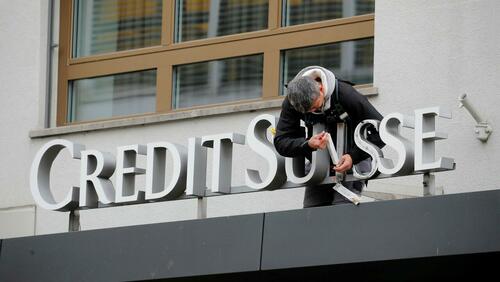
Bloomberg reports that, according to people familiar with matter, the Zurich-based firm has lined up banks including the Canadian and US firms for the possible share sale.
A capital increase, under the name Project Ghana, could come after the bank’s formal restructuring announcement on Oct. 27.
If Credit Suisse were to pull the trigger on a capital increase, it would likely seek at least $2 billion – and possibly more – to cover restructuring and any operating losses over the next couple of years as it pivots the business.
Given its $12 billion market cap, that’s quite a dilution.
Credit Suisse has already reached out to the Qatar Investment Authority to gauge interest in a potential capital injection, along with other Middle Eastern funds, such as Abu Dhabi’s Mubadala Investment Co. and Saudi Arabia’s Public Investment fund.
A capital hike, while dilutive by its nature for shareholders is being welcomed by investors so far with CS stock up in the pre-market…
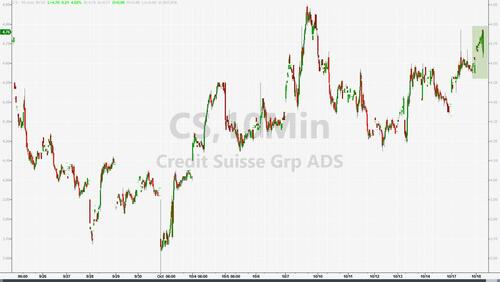
And Credit Suisse credit risk has tumbled notably…
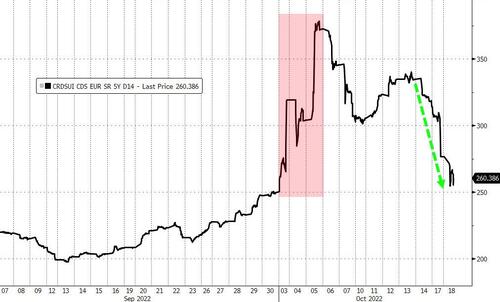
Finally, according to the same people ‘who are familiar with the matter’, ahead of next week’s announcement, the bank is accelerating its plans on asset disposals, including the likely partial sale of its securitized products unit.
END
5. RUSSIAN AND MIDDLE EASTERN AFFAIRS
RUSSIA/UKRAINE
At least 1/3 of Ukraine’s power stations were destroyed. Ukraine is expecting a brutal winter
(zerohedge)
One-Third Of Ukraine’s Power Stations Destroyed As WHO Warns Of “Brutal” Winter Ahead
TUESDAY, OCT 18, 2022 – 10:05 AM
Ukrainian President Volodymyr Zelensky announced Tuesday that up to one-third of all power stations have been attacked by Russian missile and drone strikes over the past week, causing “massive blackouts across the country.”
He called these ongoing strikes against energy infrastructure “terrorist attacks” and said this means there’s “No space left for negotiations with Putin’s regime,” according a tweet.
For more than a week Russia has stepped up an aerial bombardment campaign against dozens of cities and towns which has included widespread use of suicide drones. Ukraine and its Western backers suspect these are Iranian-made drones, cause the EU to threaten new sanctions against Tehran on Tuesday.

Zelensky said in a separate social media post that Russian forces act “insidiously – kills civilians, hits housing, infrastructure,” according to a Telegram statement. “Due to the Russian missile terror in some cities and regions of Ukraine, energy workers have to limit the supply of electricity so that the entire system works stably.”
The Hill on Tuesday wrote of some the latest strikes, “The city of Zhytomyr, which is west of the capital Kyiv, lost power after a double missile strike targeted an energy facility on Tuesday.” The report observed further that “In Kyiv, missile strikes damaged two power facilities and on Monday the city was bombarded by waves of exploding suicide drones.”
Ukraine’s second largest city of Kharkiv, which sits near the Russian border, was also hit in a major attack on its energy infrastructure. This has threatened the power grid in a city with a pre-war population of nearly 1.5 million. Reuters has called it a “deliberate campaign to destroy electricity and water facilities before winter.”
The two Russian regions of Belgorod and Kursk have meanwhile said their populations have been terrorized by shelling attacks from the Ukrainian side of the border. “Train traffic in the Belgorod region was temporarily brought to a halt after shelling struck a railway station and damaged the railroad tracks, the region’s Governor Vyacheslav Gladkov wrote on his official Telegram channel,” The Moscow Times reports.
“One man was wounded by shrapnel in his legs and two villages experienced power outages, he added,” the publication said. “In the Kursk region, Governor Roman Starovoit reported that Ukraine shelled the villages of Tetkino and Popovo-Lezhachi, also bringing power outages to the region.”
These new waves of Russian attacks on Ukraine’s energy come amid a World Health Organization (WHO) warning for Ukraine and perhaps even all of Europe:
WHO Regional Director for Europe Hans Henri P. Kluge said at the media briefing that the organization is working to anticipate and prepare for the challenges of the approaching “brutal” winter in its humanitarian response to Russia’s war on the country.
Kluge remarked that risk of COVID-19, frostbite, hypothermia, pneumonia, stroke and heart attack will likely increase among Ukrainians who are living “precariously,” whether in substandard shelters, without access to heating or by regularly moving to different locations.
“The destruction of houses and lack of access to fuel or electricity due to damaged infrastructure could become a matter of life or death if people are unable to heat their homes,” Kluge emphasized.
Despite billions of dollars in humanitarian aid continuing to flow to Kiev from Western allied governments, the degradation of infrastructure could still take years to fix, especially amid threatening war-time conditions and logistical challenges of getting parts to make rapid fixes.
END
RUSSIA/ISRAEL
This is escalating quite fast if Israel provides Ukraine with lethal aid(zerohedge)
Russia Warns Israel That Lethal Aid To Ukraine Will “Destroy” All Ties
TUESDAY, OCT 18, 2022 – 02:45 AM
Russia has put Israel on notice over significant ongoing rumors that the Israeli government is preparing to supply Ukraine with lethal military aid. So far its aid has been only humanitarian and non-lethal equipment, with Israeli leaders thus far rejecting repeat requests from Kiev for arms, including the famous Iron Dome anti-air system.
There’s currently no evidence that the Knesset has authorized or pulled the trigger on defensive aid, but some Israeli officials are getting increasingly vocal about the possibility in response to widespread reports of the Iranians sending Moscow ‘kamikaze’ drones alleged to have been used in the latest stepped-up attacks.
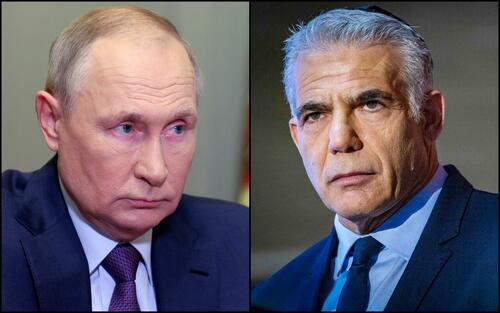
The latest international reports suggest Tehran is delivering Iranian ballistic missiles to Russia a part of war-time resupply efforts. Alarmed over the deepening ties and alleged transfers, Israeli Diaspora Affairs Minister Nachman Shai stated on Twitter Sunday the “time has come” for Israel to join allies in the West in sending arms to Kiev.
“There is no longer any doubt where Israel should stand in this bloody conflict,” Shai wrote. “The time has come for Ukraine to receive military aid as well, just as the U.S. and NATO countries provide.”
On Monday EU foreign policy chief Josep Borrell said his office is gathering evidence on Iranian drone transfers to Russia, which has reportedly included hundreds of “Shahed” drones. Multiple suicide drones struck central Kiev on Monday. This could pave the way for new, expanded EU sanctions on the Islamic Republic.
In response to Israel signaling it could send weapons into the conflict, on Monday top Russian national security council official and ex-president Dmitry Medvedev warned Israel that sending weaponry to Ukraine would destroy relations…
“It seems Israel will supply weapons to the Kyiv regime. A very reckless move. It will destroy all diplomatic relations between our countries,” Medvedev wrote on Telegram.
Tensions have been growing especially after a statement by Prime Minister Yair Lapid a week ago which condemned stepped up Russian airstrikes on Ukrainian cities.
Russian forces unleashed dozens of suicide drones across Ukraine on Monday…
“I strongly condemn the Russian attacks on the civilian population in Kyiv and other cities across Ukraine,” Lapid said. “I send our sincere condolences to the families of the victims and the Ukrainian people.”
end
RUSSIA//UKRAINE//BELARUS
Belarus to hold live fire drills with Russia amid troop surge
(zerohedge)
Belarus To Hold Live Fire Drills With Russia Amid Troop Surge
TUESDAY, OCT 18, 2022 – 04:15 AM
Belarus on Monday announced new live-fire drills with Russian forces currently mustering on Belarusian soil. “The Belarusian defense ministry said on Monday it will conduct live fire exercises and anti-aircraft guided missile launches as part of its joint grouping with Russian forces, Interfax reported,” as cited in Reuters.
“Military units from the formations are planned to be deployed at four training ranges of the Republic of Belarus in the eastern and central part of the country, after which they will start conducting combat training activities,” Interfax detailed, quoting the Belarusian military.
Ukraine and its Western allies are watching the build-up of activity near the northern border following last week’s jointly announced new military “grouping” of Russian and Belarusian forces. On Saturday the first wave of new Russian troops arrived. Minsk has indicated the Russian contingent will make up less than 9,000 troops.

Few other details were given in the initial statement, such as timeframe, but Kiev is taking this as a sign of Russian escalation – at a moment its cities are coming under increased missile and drone attacks.
While Belarus has throughout the conflict appeared only indirectly supportive of Russian forces, particularly logistics, it played host to tens of thousands of Russian forces in the weeks leading up to the Feb.24 invasion. That too had been dubbed part of “training exercises”.
A potentially alarming aspect as to the timing of the announced ‘live fire’ drills is that NATO just kicked off its own annual large-scale nuclear exercises in the region of the North Sea. Belarus’ announcement could be aimed at ‘mirroring’ the West’s drills with its own bit of muscle-flexing.
According to details presented in Russian state media, “Thousands of Russian troops will be arriving in Belarus with some 170 tanks, up to 200 armored vehicles, and up to 100 artillery pieces, Valery Revenko, an aide to the Belarussian defense minister, said on Twitter on Monday. The troops will be hosted as part of the recently created joint military force.”
And further, “Minsk decided to bolster its security by hosting Russian troops after its attempts to de-escalate border tensions were rejected, Revenko claimed to have told the military attaches.”
Could this be the start of greater direct Belarusian involvement in Ukraine? Both Putin and Lukashenko have been warning NATO over heavier and more advanced weapons being supplied to Ukraine, which they say is a direct threat to the their respective homelands.
END
RUSSIA/EURASIA
A must read. How Asia is joining forces with Russia against the West
Pepe Escobar
Escobar: Russia Courts Muslim Countries As Strategic Eurasian Partners
TUESDAY, OCT 18, 2022 – 02:00 AM
Authored by Pepe Escobar,
Everything that matters in the complex process of Eurasia integration was once again at play in Astana, as the – renamed – Kazakh capital hosted the 6th Conference on Interaction and Confidence-Building Measures in Asia (CICA).
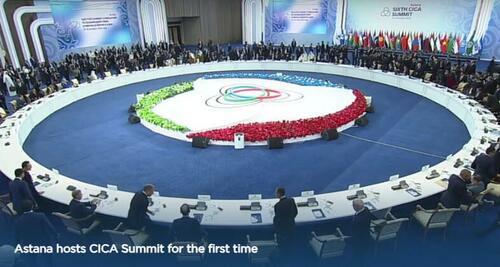
The roll call was a Eurasian thing of beauty – featuring the leaders of Russia and Belarus (EAEU), West Asia (Azerbaijan, Turkey, Iraq, Iran, Qatar, Palestine) and Central Asia (Tajikistan, Uzbekistan, Kyrgyzstan).
China and Vietnam (East and Southeast Asia) attended at the level of vice presidents.
CICA is a multinational forum focused on cooperation toward peace, security, and stability across Asia.,Kazakh President Tokayev revealed that CICA has just adopted a declaration to turn the forum into an international organization.
CICA has already established a partnership with the Eurasia Economic Union (EAEU). So in practice, it will soon be working together side-by-side with the SCO, the EAEU and certainly BRICS+.
The Russia-Iran strategic partnership was prominently featured at CICA, especially after Iran being welcomed to the SCO as a full member.
President Raeisi, addressing the forum, stressed the crucial notion of an emerging “new Asia”, where “convergence and security” are “not compatible with the interests of hegemonic countries and any attempt to destabilize independent nations has goals and consequences beyond national geographies, and in fact, aims to target the stability and prosperity of regional countries.”
For Tehran, being a partner in the integration of CICA, within a maze of pan-Asia institutions, is essential after all these decades of”maximum pressure” unleashed by the Hegemon.
Moreover, it opens an opportunity, as Raeisi noted, for Iran to profit from “Asia’s economic infrastructure.”
Russian President Vladimir Putin, predictably, was the star of the show in Astana. It’s essential to note that Putin is supported by “all”nations represented at CICA.
High-level bilaterals with Putin included the Emir of Qatar: everyone that matters in West Asia wants to talk to “isolated” Russia.
Putin called for “compensation for the damage caused to the Afghans during the years of occupation” (we all know the Empire of Chaos, Lies and Plunder will refuse it), and emphasized the key role of the SCO to develop Afghanistan.
He stated that Asia, “where new centers of power are growing stronger, plays a big role in the transition to a multipolar world order”.
He warned, “there is a real threat of famine and large-scale shocks against the backdrop of volatility in energy and food prices in the world.”
Hefurther called for the end of a financial system that benefits the “Golden billion” – who “live at the expense of others” (there’s nothing “golden” about this “billion”: at best such definition of wealth applies to 10 million.)
And he stressed that Russia is doing everything to “form a system of equal and indivisible security”. Exactly what drives the hegemonic imperial elites completely berserk.
“Offer you can’t refuse” bites the dust
The imminent juxtaposition between CICA and the SCO and EAEU is yet another instance of how the pieces of the complex Eurasia jigsaw puzzle are coming together.
Turkey and Saudi Arabia – in theory, staunch imperial military allies – are itching to join the SCO, which has recently welcomed Iran as a full member.
That spells out Ankara and Riyadh’s geopolitical choice of forcefully eschewing the imperial Russophobia cum Sinophobia offensive.
Erdogan, as an observer at the recent SCO summit in Samarkand, sent out exactly this message. The SCO is fast reaching the point where we may have, sitting at the same table, and taking important consensual decisions, not only the “RICs” (Russia, India, China) in BRICS (soon to be expanded to BRICS+) but arguably the top players inMuslim countries: Iran, Pakistan, Turkey, Saudi Arabia, Egypt and Qatar.
This evolving process, not without its serious challenges, testifies to the concerted Russia-China drive to incorporate the lands of Islam as essential strategic partners in forging the post-Western multipolar world. Call it a soft Islamization of multipolarity.
No wonder the Anglo-American axis is absolutely petrified.
Now cut to a graphic illustration of all of the above – the way it’s being played in the energy markets: the already legendary Opec+ meeting in Vienna a week ago.
A tectonic geopolitical shift was inbuilt in the – collective – decision to slash oil production by 2 million barrels a day.
The Saudi Foreign Ministry issued a very diplomatic note with a stunning piece of information for those equipped to read between the lines.
For all practical purposes, the combo behind the teleprompter reader in Washington had issued a trademark Mafia threat to stop “protection” to Riyadh if the decision on the oil cuts was taken before the US mid-term elections.
Only this time the “offer you can’t refuse” didn’t bite. OPEC+ made a collective decision, led by Russia, Saudi Arabia and the UAE.
Following Putin and MBS famously getting along, it was up to Putin to host UAE President Sheikh Zayed – or MBZ, MBS’s mentor – at the stunning Konstantinovsky Palace in St. Petersburg, which datesback to Peter the Great.
That was a sort of informal celebration of how OPEC+ had provoked, with a single move, a superpower strategic debacle when it comes to the geopolitics of oil, which the Empire had controlled for a century.
Everyone remembers, after the bombing, invasion and occupation of Iraq in 2003, how US neo-cons bragged, “we are the new OPEC”.
Well, not anymore. And the move had to come from the Russians and US Persian Gulf “allies” when everyone expected that would happen the day a Chinese delegation lands in Riyadh and asks for payment of all the energy they need in yuan.
OPEC+ called the American bluff and left the superpower high’n dry. So what are they going to do to “punish” Riyadh and Abu Dhabi? Call CENTCOM in Qatar and Bahrain to mobilize their aircraft carriers and unleash regime change?
What’s certain is that the Straussian/neocon psychos in charge in Washington will double down on hybrid war.
The art of “spreading instability”
In St. Petersburg, as he addressed MBZ, Putin made it clear that it’s OPEC+ – led by Russia, Saudi Arabia and the UAE – that is now setting the pace to “stabilize global energy markets” so consumers and suppliers would “feel calm, stable and confident” and supply and demand “would be balanced”.
On the gas front, at Russian Energy Week, Gazprom CEO Alexey Miller made it clear that Russia may still “save” Europe from an energy black hole.
Nord Stream (NS) and Nord Stream 2 (NS2) may become operational: but all political roadblocks must be removed before any repairing work starts on the pipelines.
And on West Asia, Miller said additions to Turk Stream have already been planned, much to the delight of Ankara, keen to become a key energy hub.
In a parallel track, it’s absolutely clear that the G7’s desperate gambit of imposing an oil price cap – which translates as the weaponization of sanctions extended to the global energy market – is a losing proposition.
Slightly over a month before hosting the G20 in Bali, Indonesian Finance Minister Sri Mulyani Indrawati could not make it clearer:
“When the United States is imposing sanctions using economic instruments, that creates a precedent for everything”, spreading instability “not only for Indonesia but for all other countries.”
Meanwhile, all Muslim-majority countries are paying very close attention to Russia. The Russia-Iran strategic partnership is now advancing in parallel to the Russia-Saudi-UAE entente as crucial vectors of multipolarity.
In the near future, all these vectors are bound to unite in what ideally should be a supra-organization capable of managing the top story of the 21st century: Eurasia integration.
END
IRAN/RUSSIA
Troublesome: Iran sending more missiles and drones to Russia. Russia threatens Israel harm, if they supply to Ukraine the Iron Dome as a defense shield against these attacks
(zerohedge)
Iran Sending More Missiles & Drones To Russia Despite West’s Sanctions Threat
TUESDAY, OCT 18, 2022 – 12:26 PM
Allegations of increased Iranian military weaponry transferred to Moscow for use in Ukraine has brought the Islamic Republic under greater EU and US scrutiny, as both begin moving toward imposing fresh sanctions on Tehran as they gather evidence.
Reuters is reporting Tuesday that a deal for surface-to-surface missiles has been made, along with more drones, citing a handful of unnamed top Iranian officials. The outlet said in an exclusive, “A deal was agreed on Oct. 6 when Iran’s First Vice President Mohammad Mokhber, two senior officials from Iran’s powerful Revolutionary Guards and an official from the Supreme National Security Council visited Moscow for talks with Russia about the delivery of the weapons.”

One of the Iranian officials told Reuters, “The Russians had asked for more drones and those Iranian ballistic missiles with improved accuracy, particularly the Fateh and Zolfaghar missiles family.”
The West has long worried that Russia would turn to unsavory “rogue” states to resupply its fast depleting munitions for use in its Ukraine assault. This past week in particular has seen Russia for the first time rely heavily on repeat drone strikes on the Ukrainian capital of Kiev and other major cities.
On October 10, when this latest round of widespread Russian aerial bombardment began, Ukrainian President Volodymyr Zelensky denounced in particular the Kremlin’s alleged reliance on foreign ‘suicide drones’. “We are dealing with terrorists,” Zelensky said in those remarks. “Dozens of missiles, Iranian Shaheds.”
With news of a fresh impending weapons transfer between Tehran and Moscow, the EU is reported to be moving toward new sanctions preparations. In the background is also the stalled JCPOA nuclear deal, already unraveling, but a new round of sanctions could prove the final death blow. According to a press briefing by the EU’s foreign affairs chief:
“We are following very closely the use of drones. We are gathering evidence, and we will be ready to react with the tools at our disposal,” EU’s chief diplomat Josep Borrell told reporters after the ministers’ meeting. “These [sanctions] processes have to be based on evidence. Evidence exists; it has been provided by the relevant intelligence services,” Borrell said.
“Once all the evidence is available, and there is a lot already, I don’t think there will be any problem with future steps taken by member states,” he added.
The US State Department chimed in on Monday, with spokesman Vedant Patel saying, “Earlier today our French and British allies publicly offered the assessment that Iran’s supply of these UAVs (for) Russia is a violation of U.N. Security Council resolution 2231.” Patel added in the press briefing: “This is something that we agree with.”
This indeed suggests that new sanctions are just around the corner. Tehran for its part has expressly denied that it has been supplying drones or other advanced weaponry to Russia for use in Ukraine, while the Kremlin has kept silent on the charges.
Starting in August, The Washington Post, The Associated Press, and others began reporting that the first Iranian shipment of Shahed drones were en route to Russia’s military. Numerous widely circulating social media videos out of Ukraine strongly suggest that some unknown number of Shaheds have indeed been deployed.
* * *
END
6. GLOBAL ISSUES//COVID ISSUES//VACCINE ISSUES.
Vaccine//Covid issues:
Corruption scandal hangs over EU President Ursula von der Leyen
A powerful investigative committee in Germany is looking into contracts awarded when von der Leyden was defence minister, potentially tainting her new role as the political figurehead of the EU.
Shortly after the European Commission President Ursula von der Leyen, took office in September 2019 she gave a speech on the damaging impact corruption has on society at large and made it a focus of her mandate.
Closer to home in Germany, however, where the EU’s top decision-maker is from, an ongoing investigation is digging into lucrative contracts that were illegally awarded by Leyen and her senior staff when she was the defence minister, in what has been described as corrupt practices.
Von der Leyen was hauled in front of a powerful investigative committee of German MPs as evidence has mounted that there may have been tampering with her phones when they were handed back to the ministry and fully wiped of any information which may have proved valuable to the investigation.
The wide-ranging investigation has resulted in 30 witnesses being called and more than 4,000 documents collected. A circle of nepotistic relationships were allowed to accrue around the former German defence minister, which resulted in contracts being awarded in the hundreds of millions.
When auditors were tasked with investigating how external contractors were awarded they found that in 2015 up €100 million had been spent but only €2.2 million was declared.
Investigators found a similar pattern in 2016 with von der Leyen’s ministry spending €150 million while declaring expenditure amounting €2.9 million.
Further questions have been raised on why lucrative contracts were awarded to the global consulting giant McKinsey & Company, where von der Leyen’s son works as an associate and whether there was a conflict of interest in the decision-making process.
The investigation which is also looking at nepotism marks a humiliating low point for von der Leyen’s leadership that will inevitably be exploited by her opponents within the EU bloc.
Breitbart London, an immensely popular far-right outlet, has already sought to frame the scandal as ‘Hillary 2.0? Data on New EU President’s Official Phone Wiped‘, alluding to sensitive government emails that the former US presidential candidate stored in a privately unsecured server.
Hillary Clinton deleted the emails before she could be investigated – a fact that Donald Trump used to bludgeon his political opponent, painting her as corrupt.
Von der Leyen’s mandate was considered by some as weak when she won by a margin of just nine votes garnering 383 parliamentarians.
“A slim margin of fewer than 400 votes is generally seen as a weak mandate that will make it difficult to secure legislative majorities for the five-year term,” said Alexandra Hennessy, a senior lecturer in Government at the University of Essex in the UK.
The revelations also cast a shadow around German Chancellor Angel Merkel’s waning premiership and increasing political difficulties. Von der Leyen was a close confidant to the chancellor for more than 14 years before she took her new job at the EU.
Between 2013 and 2019 von der Leyen served as a defence minister and it is during this time when most of the questionable practices have occurred.
The revelations about the former defence minister also come as the German chancellor’s anointed successor unexpectedly quit dealing a blow to Merkel’s succession ambitions and potentially threatening the tail end of her leadership which ends in 2021.
GLOBAL ISSUES
Cargo Shipowners Cancel Sailings as Global Trade Flips From Backlogs to Empty Containers – Era of Light
| Robert Hryniak | 1:41 PM (6 minutes ago) |   | |
to |
Winter stock is here, so what does this say about spring and summer 2023?
end
PAUL ALEXANDER
VAIDS (Vaccine Acquired Immune Deficiency Syndrome) Crisis Imminent: in this case COVID vaccine related; Nursing Report from the Nicklaus Children’s Hospital in Miami; very serious situation we face
Our young children are & will be in serious danger with these COVID gene injections, it is and will cause havoc to their immune systems. It already is, rare & benign diseases emerging, all on the rise
| Dr. Paul AlexanderOct 18 |
Good review by Igor, good reporting:
‘My nurse tipster has been employed at the Nicklaus Children’s Hospital in Miami for a decade, and emailed yours truly the following:
I’ve been working at a Miami children’s hospital for 10 years and we are now going back to doubling rooms because there is no space for the patients.
Admission numbers are astronomical. We are now doubling rooms which was eliminated prior to covid, and this would have been considered unheard of after covid.
Every sort of disease and ailment is on the rise. Symptomatic covid is barely a blip, as it does nothing to children other than mild cold/flu symptoms.
Staffing is always short and new hires are nurses straight out of nursing school with no desire to work this hard and with a serious culture shock.
We are stretched super thin and holes are being filled by inexperienced staff when they are even available.
Upper respiratory infections are common now along with reoccurring chronic conditions. Saw two teenage patients recently with vasculitis.
None of this is normal. I have never seen these kinds of admissions like this especially during early fall. Based on the trends I am seeing I think what you have been writing is right and things will get a lot worse all because of the vaccine.
This happens to perfectly gibe with yesterday’s article:
2nd Smartest Guy in the World
An Early Preview of Flu Season or VAIDS Season?
My tipster just emailed me the following: I know you focus on the big picture, but sometimes reading a local take on things makes people start to think about what is also probably starting to happen in their own community. This one’s an eye opener…
END
Dr. McCullough reminds us about overlapping sequelae of COVID from viral replication initial phase, to cytokine immune inflammatory phase to thrombotic phase & and the failures of doctors, IDSA & NIH
In short, understanding Complex Illness is Key to Successful Therapy
| Dr. Paul AlexanderOct 18 |
‘Coming up on three years of COVID-19 pandemic, clinicians have learned to appreciate the severity of illness that can occur in hospitalized patients. Grapsa, et al, published in JAMA on hospitalized patients from the Alpha to Omicron era in three Greek tertiary centers and found among survivors the hospital length of stay was 70 and 36.5 days for fully vaccinated and unvaccinated patients, respectively.[i] The 28-day mortality for those requiring mechanical ventilation was 61.5% and 68.2%, for fully vaccinated and unvaccinated patients, respectively.
While confounding was not sufficiently handled to draw conclusions regarding vaccination and clinical outcomes, it is fair to say that both vaccinated and unvaccinated patients with severe COVID-19 have very high mortality and for the survivors, they must endure more than a month in the hospital. When McCullough et al, described three overlapping phases of COVID-19 illness in the “index” or first occurrence (viral replication, cytokine storm, and thrombosis) it allowed clinicians to approach the illness in a sequential manner and led to the understanding that a single drug would not provide comprehensive treatment for those at the highest risk of requiring hospitalization.

It is disappointing that none of the Infectious Disease Society of America (IDSA) or National Institutes of Health Guidelines (NIH) properly conceptualized the illness in this manner. As a result, the first NIH guideline in October of 2020, indicated that no treatment should be given to a patient in the ambulatory phase and only when hospitalized and requiring oxygen should the antiviral remdesivir be given as the initial therapy. For the average patient who has been ill at home for two weeks, one can see from the figure that the viral proliferation phase is nearly complete, and the patient is well into cytokine storm (inflammation) and pulmonary microthrombosis causing oxygen desaturation and respiratory distress. It is obvious from the figure it is far too late for remdesivir at that point and clinical priorities should be focused on supportive measures, anti-inflammatories, and anticoagulation. It should come as no surprise that in November, 2020, the World Health Organization advised against remdesivir for inpatient treatment of COVID-19.[ii]
Sadly, the IDSA and NIH guidelines did not improve care and have been considered “not trustworthy” by the Academy of Critical Care: Development, Evaluation, and Methodology (ACCADEMY).[iii] Correct understanding of the multifaceted and phased natural history of COVID-19 led to the innovation of multi-drug therapy that begins ideally on day one of the illness and with the goal of shutting off the progression of disease to avoid hospitalization, mechanical ventilation, and death. When the debacle of government agency pandemic response is reviewed, likely this figure to appear and watch agency officials answer questions on why the U.S. featured the late use of remdesivir for inpatient treatment? Expect questions on why the agencies proposed the antiviral Paxlovid to work as monotherapy? Finally, there will be strong statements about how our government agencies failed to ask for “second opinions” from experts who were gaining insight on the phases of COVID-19 and matching successful therapy for patients in the community using multidrug regimens.[iv] ‘
![]() Courageous Discourse with Dr. Peter McCullough & John Leake
Courageous Discourse with Dr. Peter McCullough & John Leake
McCullough Protocol©: Three Phases of Index COVID-19
Coming up on three years of COVID-19 pandemic, clinicians have learned to appreciate the severity of illness that can occur in hospitalized patients. Grapsa, et al, published in JAMA on hospitalized patients from the Alpha to Omicron era in three Greek tertiary centers and found among survivors the hospital length of stay was 70 and 36.5 days for …
| Open in browserYuval Noah Harari, World Economic Forum (WEF) adviser, said, “We just don’t need the vast majority of the population” in the early 21st century; they are USELESS eaters & to be culled Making human labor economically and militarily “redundant.” “Useless eaters” to be culled.. ..Dr. Paul Alexander Oct 18 ▷ LISTENSAVE SOURCE |
Sun et al.: “Increased emergency cardiovascular events among under-40 population in Israel during vaccine rollout and third COVID-19 wave”; the findings raise concerns regarding vaccine-induced
undetected severe cardiovascular side-effects & underscore the already established causal relationship between vaccines & myocarditis, frequent cause of unexpected cardiac arrest in young individuals.
| Dr. Paul AlexanderOct 17 |
END
‘Israel National Emergency Medical Services (EMS) from 2019 to 2021.
Evaluated the association between the volume of cardiac arrest and acute coronary syndrome EMS calls in the 16–39-year-old population with potential factors including COVID-19 infection and vaccination rates.
An increase of over 25% was detected in both call types during January–May 2021, compared with the years 2019–2020.’
SOURCE:
https://www.nature.com/articles/s41598-022-10928-z

VACCINE IMPACT/
VACCINE INJURY
MICHAEL EVERY//RABOBANK
Michael Every on the major topics of the day
“We’ve Tried This Before… Under Brüning In Weimar Germany”
TUESDAY, OCT 18, 2022 – 12:05 PM
By Michael Every of Rabobank
How Now Brüning Cow?
“How now brown cow” is a phrase used in elocution teaching to demonstrate the rounded vowel sound /aʊ/ since at least 1926, but today seen as an archaic greeting or an interrogative expression, one which I like using because Bugs Bunny did too – and he sounds like Janet Yellen. I’d really like to hear her say the phrase given we are in a Looney Tunes policy world right now without any Merry Melodies, and with a distinct 1920s feel to it.
Yesterday, markets celebrated the fiscal U-turn in the UK getting even more ‘U’. 10-year index linked Gilt yields collapsed 63bp at one point, while the nominal 10-year Gilt yield was down a mere 36bp, taking some other global yields with it to a far smaller degree. If it weren’t for the fact that year-to-date the UK 10-year yield had risen from 1% to 4.51% before now sitting around 4%, with most of that having happened before the recent mini-Budget, one might call it a “success” for Chancellor Hunt and PM Liz “this lady is for turning” Truss.
The problem is that for many in the UK, the new fiscal ‘U’ contains an expletive before it and an exclamation point afterwards. Income tax is not going to be cut; corporate tax will rise; spending will be savagely cut; and the government’s unlimited energy guarantee will now only last until April 2023: after that you are on your own with soaring prices. If it is more important to level Gilt yields down for investors than to level people up, why don’t we remove the welfare state and minimum wage, cut civil servant salaries to benchmark private sector salaries lower too, and sell off the army for scrap? That way we can get Gilts down another 350bp, if we follow Japan’s lead.
We’ve tried the Hunt (Osbourne) fiscal austerity path before. We did the same after 2008, while bailing out the financial sector and doing QE to make the rich richer, which the market is also clamouring for again now. It was a disaster that entrenched populism, Brexit, the ‘new normal’, and a hysteresis effect on GDP all responsible for the fact that a developed market now looks and acts like an emerging market. Financial markets are cheering a repeat –even as I suspect post-Hunt opinion polls will continue to point to the Tories disappearing as a political entity, and the UK becoming a de facto one party state under Labour– because they are looney and know only one tune: “tight fiscal policy, loose monetary policy”. They just aren’t going to get it. They are going to get tight fiscal and monetary policy.
We’ve tried that path before too. After 1929, under Brüning in Weimar Germany. It was the crushing deflation he started in 1930 that drove the rise of Nazism in 1933, not the inflation from 1921-23 led by a supply-side shock (France seizing the Ruhr, alongside unpayable war debts in hard currency with no means to export, and, yes, money printing to fill the gap) we teach as being solely responsible despite happening years 10 years earlier! We teach that so we can justify stupid austerity when rejecting stupid fiscal splurges. I can’t believe I have to point out such basic history to people who talk about inflation and populism for a living, but “how now Brüning cow?”
Markets are cheering this, and the BOE, regardless of this being a disaster with a lag. Even if we don’t see worse populism —and despite ECB market action ‘helping’ get rid of Berlusconi in the past, Italy has since ended up with Meloni— the UK will see collapsing tax revenues and larger deficits anyway. Firms will fail. Unemployment will soar. GDP will shrink. Everyone with half a brain knows this to be true. Then again, no one with half a brain has been anywhere near fiscal policy for years – and I include the IMF in that, not just No. 10 and 11.
Meanwhile, this not a UK issue. Although the fiscal position is not a problem for Australia, the RBA’s latest minutes underlined they are terrified of the impact on mortgage rates/housing, and are selling themselves the lie that global inflation will fall back rapidly: refer to yesterday’s Daily on my view on such ‘models’. However, the Deputy Governor just underlined that while they are lagging other central banks, that “also means that if we increase interest rates at every meeting, we can potentially move much faster than overseas central banks.” So we could see a 100bp RBA move?! I think not, but even the Aussies are realising their old policy tricks no longer work. Then what, hypothetically? Fiscal tightening into a housing slump? Or fiscal loosening and an explosion in bond yields and a collapse in A$? (And nearby, today’s Q3 Kiwi CPI data came in at 2.2% q-o-q vs. 1.5% expected and 7.2% y-o-y vs. 6.5% expected.)
I know these messages are unpopular. I know we want nice easy answers, like ‘cut taxes!’, or ‘cut spending!’, or ‘buy all of the things!’ And I know life is particularly confusing now for Right and Left alike, e.g., Kanye West ranting “Jewish Zionists control the media”, after implying he’s Jewish because African-Americans people are the lost tribes of Israel, then buying Parler, a conservative social media app US liberals already believed was full of Nazis. By the way, this is the kind of conversation that was happening in Weimar, to the embarrassment of its shrinking liberal classes, before Brüning went all in austerity to break the unions, and instead broke European civilisation.
At least the Financial Times is doing some good clarifying work with the latest in a series of columns by Rana Foroohar that echo the greatest hits of this Daily. Today’s is titled ‘Free Trade has not made us free’, and underlines that globalisation didn’t resolve underlying political differences between us; that we are heading to a post-neoliberal world where trade is about values not prices; that means higher inflation; and, as Russell Napier argues while again talking in parallel to our greatest hits, a sustained Western capex boom as industry returns (just maybe not to Europe): look at the destruction about to be wrought in Chinese semiconductors by the latest US measures. The FT continues that most low-income voters will still happily take that trade-off for a few years if it means a better-paid, more rewarding job with greater national resilience.
Of course, the UK government is being cheered for going in completely the opposite direction by markets! Richly remunerated denial always sells better than painful truth.
Perhaps the UK should just have taken a leaf out of China’s book. I don’t mean MMT into the supply side, which is being rejected now. I mean cancelling the publication of economic data for a while. I am 100% sure that this is because the Chinese data due were so outstandingly positive that the government were worried it would overwhelm us with its magnificence. There is no other reason I can think of for why it is now going to be delayed.
If you think I am being particularly flippant today it’s only because, like life, getting policy wrong again against the current geopolitical backdrop presents tail risks too important to be taken seriously. I won’t credit those making such huge errors with a dry, technocratic response. They don’t deserve one, and they won’t get one here. “How now brown cow?”
END
7. OIL//OIL ISSUES//NATURAL GAS//ELECTRICITY ISSUES/USA//GLOBE
Biden is totally insane for this
(zerohedge)
Biden Admin To Announce Another 15 Million Barrel SPR Release Before Midterms
TUESDAY, OCT 18, 2022 – 07:13 AM
Oil markets are drifting sideways this morning after the Biden administration plans to release 10-15 million barrels of crude from the Strategic Petroleum Reserve in a bid to suppress gasoline and diesel prices at the pump ahead of the next month’s congressional elections, Bloomberg said citing people familiar with the matter.
President Biden’s upcoming announcement of up to 15 million barrels, one of the largest ever, comes as 180 million barrels have been drained from the nation’s emergency stockpile since May.

For context, the Biden administration has cut the SPR to a record low 22 days worth of supply… That is not what you want to see when liberal war hawks are gunning for nuclear war.
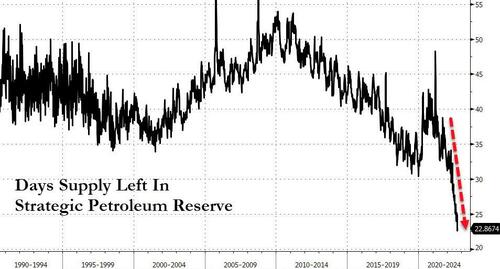
On Sunday, White House economic adviser Jared Bernstein said Biden was still mulling over the final SPR release figures. He told Fox News the reserve is 50% full.
“The fact is there is capacity to use the SPR to deal with some of the energy shocks we’re seeing in the world. But I’m not saying we will. That’s up to the president to decide, he hasn’t made that decision yet,” Bernstein said.
Last Tuesday, David Turk, the Energy Department’s deputy secretary, said, “We still have some additional ability to use the SPR over the coming weeks and months as needed.”
Turk said the administration was willing to move forward with an export ban on refined products in response to OPEC+’s decision to cut production.
But while the Biden admin was reluctant to pursue an export ban, a move that would send oil prices higher over the long run, it had fewer qualms about potentially extending its SPR drain.
Sources told Bloomberg White House officials have been discussing with oil companies, including ConocoPhillips and Exxon Mobil Corp., about what to expect in future SPR releases while encouraging crude production and boosting the capacity of refined fuels.
The US’ only problem is that refining capacity has been reduced over the years, and also, there’s seasonal maintenance underway. We outlined in the summer: US Refining Bottleneck The Culprit For Your Gas Pump Pains.
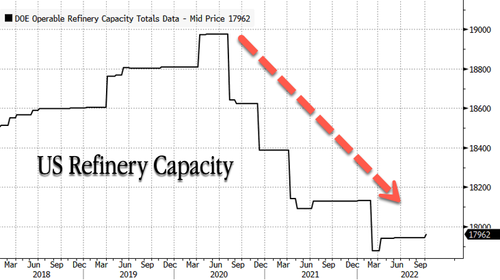
“The administration has a small window ahead of midterms to try to lower fuel prices, or at least demonstrate that they are trying,” one of Reuters‘ sources familiar with the White House deliberations.
“The White House did not like $4 a gallon gas, and it has signaled that it will take action to prevent that again,” they said.

DOE is expected to release details on repurchasing the crude. Since crude production and refining capacity is limited in the US, prices could trend higher once the SPR releases are wound down. We suspect if there’s a red wave during the midterms and fuel prices move higher into next year, and the Biden administration finally admits there’s a recession, Democrats will try to pin the economic chaos on Republicans.
END
8 EMERGING MARKET& AUSTRALIA ISSUES & OTHER EMERGING NATIONS
end
Your early currency/gold and silver pricing/Asian and European bourse movements/ and interest rate settings TUESDAY morning 7:30 AM
Euro/USA 0.98339 DOWN 0.0009 /EUROPE BOURSES // ALL GREEN
USA/ YEN 149.10 UP 0.126 /NOW TARGETS INTEREST RATE AT .11% AS IT WILL BUY UNLIMITED BONDS TO GETS TO THAT LEVEL…//YEN TOTALLY COLLAPSES
GBP/USA 1.13148 DOWN 0.00037
Last night Shanghai COMPOSITE CLOSED DOWN 3.98 PTS OR 0.13%
Hang Seng CLOSED UP 301.68 POINTS OR 1.82%
AUSTRALIA CLOSED UP 1.78% // EUROPEAN BOURSE: ALL GREEN
Trading from Europe and ASIA
I) EUROPEAN BOURSES ALL GREEN
2/ CHINESE BOURSES / :Hang SENG CLOSED UP 301.68 PTS OR 1.82%
/SHANGHAI CLOSED DOWN 3.98 PTS OR 0.13%
AUSTRALIA BOURSE CLOSED UP 1.78%
(Nikkei (Japan) CLOSED UP 380.35 PTS OR 1.42%
INDIA’S SENSEX IN THE GREEN
Gold very early morning trading: 1653.05
silver:$18.78
USA dollar index early TUESDAY morning: 112.13 UP .22 CENT(S) from MONDAY’s close.
TUESDAY MORNING NUMBERS ENDS
xxxxxxxxxxxxxxxxxxxxxxxxxxxxxxxxxxxxxxxxxxxxxxxxxxxxxxxxxxxxxxxxxxxxxxxxxxxxxxxxxxxxxxxxxxxxxxxxxxxxxxxxxxxxxx
And now your closing TUESDAY NUMBERS 1: 00 PM
Portuguese 10 year bond yield: 3.34% UP 1 in basis point(s) yield
JAPANESE BOND YIELD: +0.249% UP 0 AND 0/10 BASIS POINTS /JAPAN losing control of its yield curve/
SPANISH 10 YR BOND YIELD: 3.43%// UP 10 in basis points yield
ITALIAN 10 YR BOND YIELD 4.67 UP 1 points in basis points yield ./ THE ECB IS QE ITALIAN BONDS/SELLING GERMAN BUNDS
GERMAN 10 YR BOND YIELD: FALLS TO +2.279% DOWN 9 BASIS PTS
END
IMPORTANT CURRENCY CLOSES FOR TUESDAY
Closing currency crosses for day /USA DOLLAR INDEX/USA 10 YR BOND YIELD/1:00 PM
Euro/USA 0.98278 DOWN .0012 or 12 basis points
USA/Japan: 149.24 UP 0.268 OR YEN DOWN 27 basis points/
Great Britain/USA 1.1298 DOWN .0054 OR 54 BASIS POINTS
Canadian dollar DOWN .0087 OR 87 BASIS pts to 1.3801
xxxxxxxxxxxxxxxxxxxxxxxxxxxxxxxxxxxxxxxxxxxxxxxxxxxxxxxxxxxxxxxxxxxxxxxxxxxxxxxx
The USA/Yuan, CNY: closed ON SHORE (CLOSED ..(DOWN) AT 7.2023
THE USA/YUAN OFFSHORE: (YUAN CLOSED (UP)…. 7.2286
TURKISH LIRA: 18.59 EXTREMELY DANGEROUS LEVEL/DEATH WISH/HYPERINFLATION TO BEGIN.
the 10 yr Japanese bond yield at +0.249
Your closing 10 yr US bond yield UP 5 IN basis points from MONDAY at 4.060% //trading well ABOVE the resistance level of 2.27-2.32%) very problematic
USA 30 yr bond yield 4.091UP 8 in basis points
Your closing USA dollar index, 112.83 UP 28 PTS ON THE DAY/1.00 PM/
Your closing bourses for Europe and the Dow along with the USA dollar index closing and interest rates TUESDAY: 12:00 PM
London: CLOSED UP 21.75 PTS OR 0.31%
German Dax : CLOSED UP 144.45POINTS OR 1.14%
Paris CAC CLOSED UP 36.86PTS OR 0.61%
Spain IBEX CLOSED UP 67.58 OR 0.89%
Italian MIB: CLOSED UP 232.30PTS OR 1.09%
WTI Oil price 82.31 12: EST
Brent Oil: 88.92 12:00 EST
USA /RUSSIAN /// RUBLE RISES TO: 61.58 UP 0 AND 7/100 RUBLES/DOLLAR
GERMAN 10 YR BOND YIELD; +2.279
CLOSING NUMBERS: 4 PM
Euro vs USA: 0.98480 UP .00041 OR 4 BASIS POINTS
British Pound: 1.13107 DOWN .0040 or 40 basis pts
BRITISH 10 YR GILT BOND YIELD: 3.970%
USA dollar vs Japanese Yen: 149.74 UP 0.265//YEN DOWN 27 BASIS PTS
USA dollar vs Canadian dollar: 1.3769 UP 0.0054 (CDN dollar, DOWN 54 basis pts)
West Texas intermediate oil: 82.80
Brent OIL: 90.124
USA 10 yr bond yield DOWN 2 BASIS pts to 3.994%
USA 30 yr bond yield UP 1 BASIS PTS to 4.017%
USA dollar index:112.00 UP .100 CENTS
USA DOLLAR VS TURKISH LIRA: 18.59
USA DOLLAR VS RUSSIA//// ROUBLE: 61.57 UP 1 AND 7/100 ROUBLES
DOW JONES INDUSTRIAL AVERAGE: UP 153.75 PTS OR 0.33 %
NASDAQ 100 UP 17.23 PTS OR 0.64%
VOLATILITY INDEX: 30.78 DOWN 0.59 PTS (1.85)%
GLD: $153.75 UP 0.33 OR 0.22%
SLV/ $17.23 UP $.11 OR 1.78%
end)
USA trading day in Graph Form
Stocks Rise As Recession Odds Hit 100% For “Strong As Hell” Economy”

BY TYLER DURDEN
TUESDAY, OCT 18, 2022 – 04:01 PM
Over the weekend, President Biden declared the US economy “is strong as hell”…
Then, White House press secretary Karine Jean-Pierre then doubled-down on that narrative in today’s briefing, suggesting: “Economic indicators are not pointing to a recession…”
There’s just one thing… THEY ARE pointing to a recession.
As Bloomberg reports, The latest recession probability models by Bloomberg economists Anna Wong and Eliza Winger forecast a higher recession probability across all timeframes, with the 12-month estimate of a downturn by October 2023 hitting 100%, up from 65% for the comparable period in the previous update.
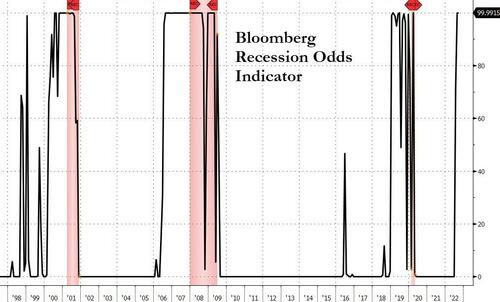
Source: Bloomberg
The Bloomberg Economics model uses 13 macroeconomic and financial indicators to predict the chance of a downturn at horizons of one month to two years.
JPMorgan Chase CEO Jamie Dimon recently warned that the United States is likely going to fall into a recession in the next six to nine months, adding that the Fed “waited too long and did too little” and is now “clearly catching up.”
For all of Biden’s optimistic remarks on the economy, the president did recently acknowledge that there is a chance that the United States would fall into a recession, though he added that it’s “very slight.”
Economist Nouriel Roubini, dubbed Dr. Doom for his accurate prediction of the market crash during the 2008–09 financial crisis, said in a recent op-ed in TIME that the view that the recession will be mild and short-lived is “dangerously naive.”
“There is ample reason to believe the next recession will be marked by a severe stagflationary debt crisis,” Roubini wrote.
So, with all that said, the market’s expectations for The Fed’s rate-hike trajectory continue to trend hawkishly (with a cycle end in March 2023 at around 4.90%), but stocks (this week) remain decoupled from that reality (for now)…
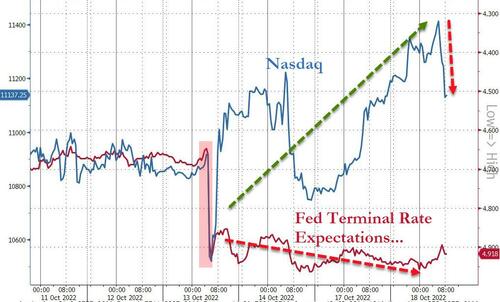
Source: Bloomberg
Overnight futures ramped ever higher on the negative delta squeeze but the US cash open saw selling appear quickly… and another leg down into the European close amid headlines and UK property fund liquidations (and a really ugly collapse in US homebuilder confidence). Stocks bounced after that but were then monkeyhammered back into the red by AAPL production cut headlines. However, a green close would not be denied and the S&P and Dow closed above 1% on the day…
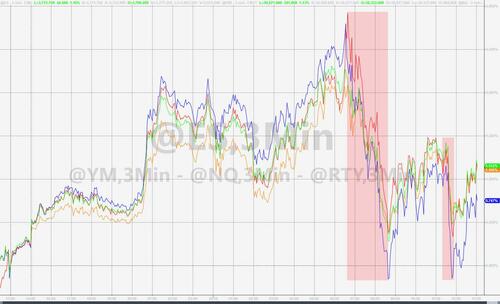
AAPL dumped into the red on the headlines today…
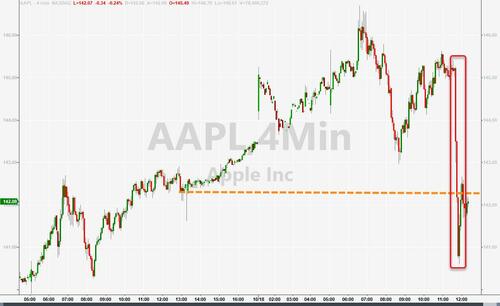
The open saw the short-squeeze continue but immediately run out of ammo…
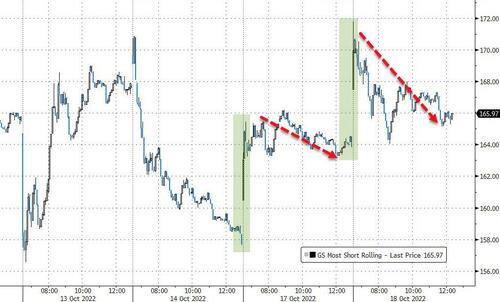
Source: Bloomberg
US equities are up over 6% from Thursday’s spike lows…

Treasuries were choppy on the day but ended lower in yield, down 1-2bps almost uniformly across the curve. On the week, the 30Y yield is the only one higher (+2.5bps) while 2Y yields are the leaders (-6.5bps)…

Source: Bloomberg
The 10Y yield burst back above 4.00% again today but by the close it was back below it…

Source: Bloomberg
The dollar chopped around all day but ended practically unchanged…
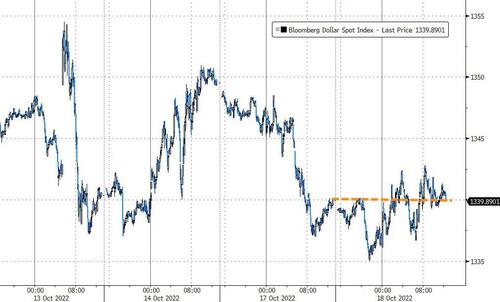
Source: Bloomberg
Bitcoin puked back down towards $19,000 (legging on the AAPL news)
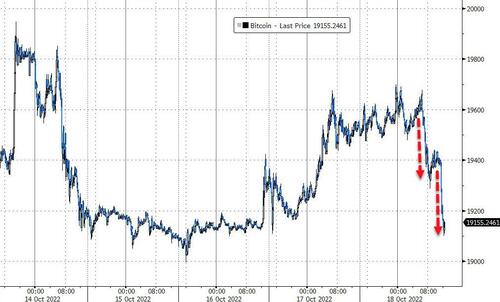
Source: Bloomberg
Gold closed marginally lower on the day…
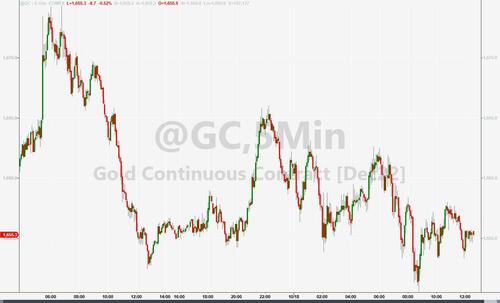
Oil prices puked today with WTI back to a $81 handle ahead of tonight’s API inventory data…
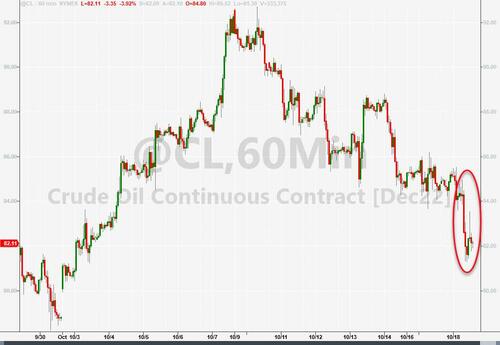
The Biden administration is preparing to announce more SPR releases tomorrow to rescue gas prices from their recent rebound. That will push the SPR even deeper into record lows in the context of days of supply…

Source: Bloomberg
Let’s just hope we really don’t suffer an emergency…
Finally, we note that the S&P 500 is back in the red since Biden took office…
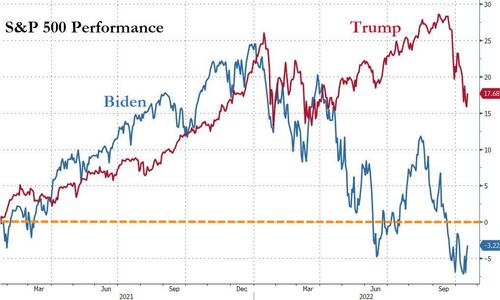
Source: Bloomberg
But the market is not the economy, right…?
I) / LATE MORNING// TRADING//
US Bonds, Stocks Are Suddenly Puking Into EU Close
TUESDAY, OCT 18, 2022 – 11:27 AM
With just minutes until the European close, US equity and bond markets are puking back earlier gains with Nasdaq almost unchanged now on the day (after being up almost 3% in the pre-open)…
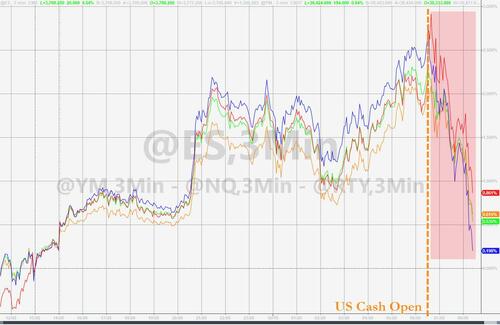
The selling started the moment the cash market opened – after another big short-squeeze…

US Treasuries are also getting smashed with yields exploding higher…
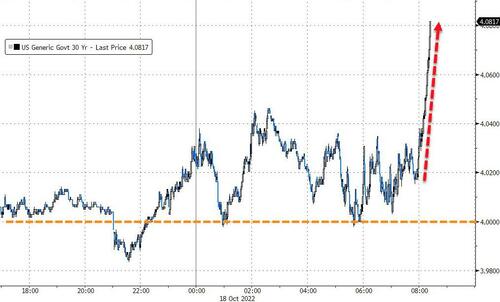
This started around 1100ET with no obvious headline catalyst.
Goldman’s Prime Desk noted that – the early action today was following the same pattern as yesterday – 240k SPX call options have traded (8k contracts per minute // 3billion notional per minute) and 620k SPY call options have traded (21k contracts per minute // 750million notional per minute).
Additionally, ETFs made up ~39% of the consolidated tape, continuing to indicate a macro product cover bid (with high vol leading to high usage of macro product)…
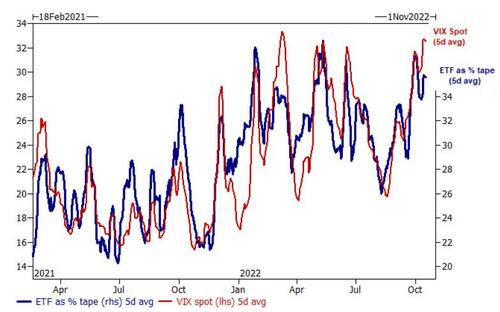
And also of note is that Goldman’s CTA work suggests that there has been almost zero demand from this cohort over the last few sessions.
AFTERNOON TRADING//
Market Tumbles On Report Apple Cutting iPhone 14 Plus Production
BY TYLER DURDEN
TUESDAY, OCT 18, 2022 – 02:48 PM
Three weeks ago Apple reportedly backed off its plans to increase iPhone production.
As Bloomberg reported at the time,. Apple is backing off plans to increase production of its new iPhones this year after an anticipated surge in demand failed to materialize.

Today, it appears that demand continues to worsen as The Information reports that Apple is cutting production of the iPhone 14 Plus less than two weeks after its debut, according to two people involved in the company’s supply chain.
Apple has told at least one manufacturer in China to immediately halt production of iPhone 14 Plus components while its procurement team reevaluates demand for the product, which Apple has positioned as a cheaper alternative to its more expensive iPhone Pro models but equipped with a large screen, according to one of the people. Two downstream Apple suppliers in China that rely on the parts and assemble them into larger modules are also cutting their production 70% and 90% respectively, the person said.
Apple shares are tumbling on the headline…
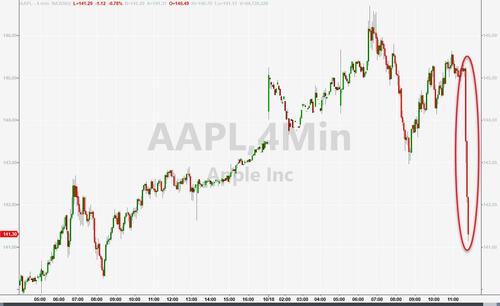
And that is dragging the overall market lower…

The news that there is just not enough demand for the trinkets and beads of the world’s largest company makes on wonder if the consumer is really as strong as the talking heads would like everyone to believe.
end
ii) USA DATA/
US Industrial Production Jumps In September As Capacity Utilization Hits 14 Year High
TUESDAY, OCT 18, 2022 – 09:24 AM
After falling for the 3 of the last 4 months, US Industrial Production was expected rise modestly in September. Instead it surged 0.4% MoM (considerably more than the +0.1% exp) and August -0.2% was revised up to -0.1% MoM. This pushed the YoY gain up 5.33% (but remember this is a notional, not inflation-adjusted level)…
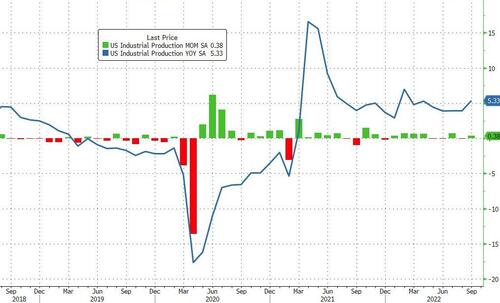
Source: Bloomberg
On the manufacturing side, production also increased more than expected in September (+0.4% MoM vs +0.2% exp) and that also saw a major upward revision for August from +0.1% to +0.5%. Manufacturing production has risen for 3 straight months and is up 4.7% YoY…
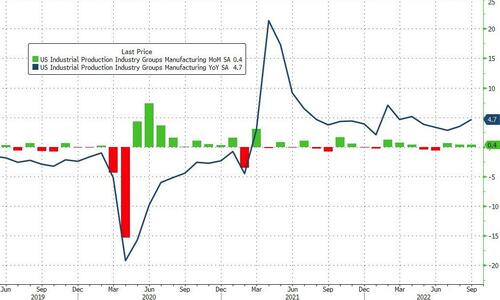
Source: Bloomberg
Capacity Utilization also rose more than expected in September, finally pushing above Aug 2018’s highs…
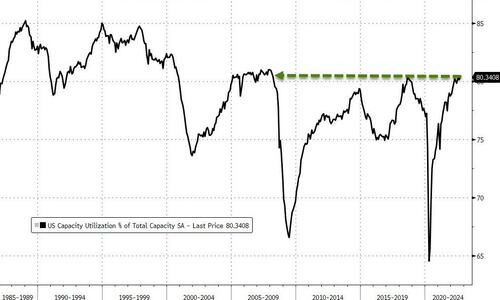
Source: Bloomberg
This is the highest utilization rate since March 2008.
This is not what The Fed would like to see from its aggressive tightening.
END
Affordability is the major problem: homebuilder confidence collapses in Oct
(zerohedge)
US Homebuilder Confidence Collapses In October, Future Sales Hope Hits Decade-Lows
TUESDAY, OCT 18, 2022 – 10:46 AM
It appears delusion and hope can only last so long – even when one’s salary depends on it – as US homebuilder confidence crashed to COVID lockdown lows in October after refusing to see what everyone else was seeing more months.. and what homebuyers were clearly feeling as prices soared along with mortgage rates and devastated affordability for most Americans. Against expectations of a small drop from 46 in September to 43 in October, the headline confidence index crashed to 38 – its lowest since the nadir of COVID-lockdown panic (that was worse than the weakest forecast of all economists surveyed)…

Source: Bloomberg
This the 10th straight monthly decline in homebuilder confidence – the longest losing streak since data began in 1985.
“While some analysts have suggested that the housing market is now more ‘balanced,’ the truth is that the homeownership rate will decline in the quarters ahead as higher interest rates and ongoing elevated construction costs continue to price out a large number of prospective buyers,” NAHB Chief Economist Robert Dietz said in a statement.
Under the hood, the report’s measure of future sales slid 11 points to 35, the lowest since 2012, while indexes of current sales and prospective buyer traffic weakened to the softest levels since May 2020.

Source: Bloomberg
This could be a very serious problem…
Mission Accomplished, Mr Powell?
end
III) USA ECONOMIC STORIES
Always pay attention to Scott Skrym….
The Fed’s Dilemma: “QT Will Break Something, And No One’s Talking About It”
TUESDAY, OCT 18, 2022 – 08:49 AM
By Scott Skyrm, Executive Vice President at Curvature Securities
If you can answer two questions correctly, you might have a unique insight into the direction of monetary policy over the next few years.
- Does the Fed really need to shrink the SOMA portfolio?
- Was Milton Friedman right? Or at least partially right?
I sit in a unique position in the financial markets. I’ve been in the Repo market for over 30 years, seen the evolution of the Fed, government programs and how they affect the markets. I’ve seen tightening and easing cycles, crises and booms. Through all of the changes, there’s one thing that’s for sure: The Repo market is a window into what’s going on behind the scenes.
There’s a lot of concern about the fed funds rate right now. Keep in mind, the Fed moves this rate up and down. It was too low for a long time and it will eventually be too high. There might be a recession. Hopefully not. These all seem really important to the market right now, but they’re not the real risk. These are events we’ve experienced many times before. They’re a natural part of the financial markets. What’s important is the unknown unknown.
That’s the “wild card.” Right now, the risk lurking in the shadows is Balance Sheet Runoff. The Fed, the markets, the regulators, and even us Repo guys have limited experience with the Fed shrinking the balance sheet. Bottom line: there’s a risk that Balance Sheet Runoff will breaking something. On top of that, no one’s talking about it! [ZH: that’s not true, Mark Cabana has been talking about it for a long time]
Balance Sheet Runoff And New Issuance
The Federal Reserve began growing the SOMA portfolio through a series of Quantitative Easing (QE) programs that originally began in November 2008. The most recent program ran from September 2019 to March 2022. The size of the balance sheet peaked at $8.9 trillion in April 2022 and, shortly thereafter, the Fed announced SOMA portfolio Runoff. That is, they would no longer reinvest the principal and interest payments they receive from maturing securities. The Fed was supposed to let $47.5 billion Treasurys and agency MBS mature each month between June and August. Beginning in September, the Fed is supposed to let $95 billion a month Runoff. At this point, there’s no official end to the Runoff, but I expect it will continue until something breaks.
Think about $95 billion of Balance Sheet Runoff each month. That’s a massive amount of Treasury and agency securities entering the market. Now, when you consider net new Treasury issuance, there’s even more Treasury supply on the way. Though I’ve seen a range of estimates, let’s assume the government budget deficit is $1 trillion. That means there’s another $83 billion a month in new securities coming into the market. Combine Balance Sheet Runoff with net new Treasury issuance and we are looking at about $178 billion of securities coming into the market each month. Every month for the foreseeable future; no end in sight. Think of it this way, there will be $1 trillion more government securities in the market by March 2023. Where’s the cash coming from to pay for these securities? I might have the answer.
Original Sin
Hopefully, the Fed learned from their mistake. No, not the mistake the equity traders say about the Fed tightening too much. Of course, hindsight is 20/20, but clearly the Fed should have ended QE in 2021. In fact, April 2021 was the date when it should have ended. At that point, as the Fed continued buying, the market was sending the cash right back to the Fed through the RRP facility. Think of it this way: The Fed was injecting liquidity into the financial system and the market didn’t need that cash, so it gave it back to the Fed. Rule of thumb, when RRP volume increases during QE buying, the program is no longer effective

Last Time Around
Because QE overstayed its welcome, the Fed now needs to wrestle with an even larger balance sheet. The last time around, Balance Sheet Runoff didn’t quite go so well. During the 2017 to 2019 Runoff period, the Fed shrunk the SOMA portfolio from $4.3 trillion to $3.6 trillion – a total of about $700 billion. From 2017 through 2018, the market absorbed that supply without incident. At least for a while. During that period, the Repo GC rate slowly moved from the bottom of the fed funds target range to the top. By the end of 2018, Repo GC was actually trading above the target range.
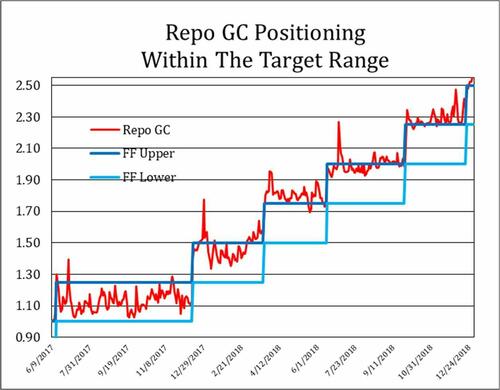
However, things went sideways at the end of the 2018. During 2018 year-end, Repo GC spiked to 7.25%. Luckily, rates didn’t spike again over the next few months and the rate spike was attributed to, well, year-end. However, year-end 2018 was the harbinger of things to come. Nine months later, on September 17, 2019, Repo GC rates spiked again, trading as high as 9.25%. This event went down in the history books as the Repo market panic, the Repo rate spike, or the Repo rate crisis. The history books blame the rate spike on declining “bank reserves.”
That brings us to the current Balance Sheet Runoff. I can tell you what I believe will happen in the Repo market. The Repo market can pay for the securities. The securities can be financed. Think of the RRP facility as a giant “holding tank” of liquidity – $2.2 trillion worth. As securities come in, cash will be pulled out of the RRP to finance them. Assuming there’s about $178 billion arriving in the market each month, it will take about a year for the RRP to drain to zero.
Once the RRP is out of cash, the Repo market will need to attract cash from other short-term markets. Overnight Repo rates will migrate from the bottom of the fed funds target range to the top. Kind of like the last time.
Here’s an important point: There’s plenty of cash around because of the RRP facility, but who’s going to absorb all of those securities on their balance sheet? Someone needs to intermediate between the leveraged investors and the cash providers. Banks are already telling clients they will have balance sheet constraints on the horizon. They’re warning clients that they have limited ability to increase their RWA,3 so clients can’t count on funding increases.
This could be true, assuming banks are expected to intermediate a significant proportion of the new supply. Soon, banks will lobby the Fed to have the Supplementary Leverage Ratio (SLR) lifted. The last time the market absorbed a large number of government securities in a short period of time was during the COVID Crisis in March 2020.5 To help the banks intermediate, the Fed exempted them from the SLR from April 2020 to March 2021. For a year, banks had fewer balance sheet restrictions and, no surprise, they liked it!
Cash Market
That’s the situation in the Repo market. Unfortunately, the impact will be different in the cash market. There’s no “holding tank” of cash available to purchase securities like there is in the Repo market. The market needs to absorb the securities itself. Who will buy the Treasurys and MBS? Perhaps investment portfolios and some central banks. Maybe some corporate treasurers and some insurance companies. Not the Money Market Funds since the duration of the securities is too long. That leaves the hedge funds. The hedge funds will be buyers when there’s a Relative Value opportunity.
As more Treasurys and agencies arrive in the market, it will push the Treasury yield curve higher relative to other yield curves. Think about the impact of $1 trillion of supply coming into the market over the next six months. That’s $2 trillion over the next year and maybe $4 trillion of the next two years. It will create havoc in the financial markets. I believe Treasury rates can only go in one direction: higher.
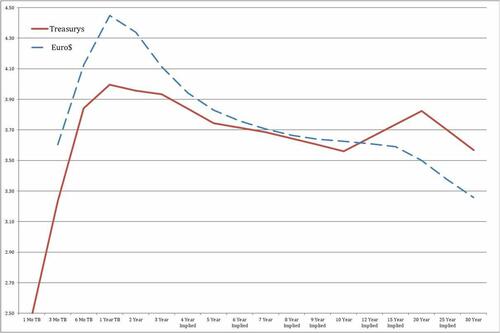
Over the next few years, the government bond market will return to similar state as the 2017-2019 period. That was the last time the market was supersaturated with government securities. Back then, every hedge fund owned as many Treasurys as they possibly could. They hedged their long positions with futures and swaps. At the same time, every REIT owned as many agency MBS as they possibly could. There was a constant scramble for balance sheet. Everyone wanted more balance sheet because the wide spreads made fixed income trading pretty easy. Repo rates were extremely volatile, especially over quarterend.
The Final Cut
That gets us back to the first question. If Balance Sheet Runoff will cause all of these problems, why run down the balance sheet at all? Why not just keep a massive balance sheet? All the Fed needs to do is declare that the size of the balance sheet is “appropriate” for the current size of the economy. However, maybe there are unintended consequences of a large balance sheet that no one is talking about?
Getting back to the Milton Friedman question. What if he was right? Or even partially correct? Milton Friedman launched the Monetarist approach to economic theory. “Helicopter Money,” though often attributed to Ben Bernanke, was originally a Friedman idea. Without getting too much in the weeds, according to Friedman: ‘Inflation is always and everywhere a monetary phenomenon.’
Currently, most officials and economists believe that raising interest rates will slow down the economy and cure inflation. If the current bout of inflation was due to high oil prices and “supply chains,” that’s a valid solution. If a significant component of inflation is from the liquidity that came from the QE program, then the Fed could keep raising rates, put us into a recession, and it still doesn’t fully solve the inflation problem.
Just for argument’s sake, let’s assume inflation is at least partially a monetary phenomenon. Maybe a percentage increase in the money supply doesn’t necessarily translate one-for-one into inflation, but there’s some impact. Pumping $5 trillion into the economy through QE purchases must have some effect on the price level. If you accept that some of that $5 trillion is driving some of the current inflation, then the solution to the inflation problem must include shrinking the balance sheet.
That means the inflation problem can’t be solved without withdrawing liquidity from the financial system. Therein lies the dilemma. If the Fed runs down the SOMA portfolio too much, they will break something in the market. If they don’t, we are stuck with inflation.
end
Extreme Cold May Trigger Power Blackouts Across New England
MONDAY, OCT 17, 2022 – 04:40 PM
Last month we informed readers, “New England’s Power Crisis Set To Return.” Fast forward to today, as US Northeast temperatures steadily decline as heating demand increases, New England power producers warn grid strains are inevitable as natural gas supplies tighten.
New England consists of six states in the US Northeast, Connecticut, Maine, Massachusetts, New Hampshire, Rhode Island, and Vermont. The region faces a power crisis every winter because its power grid relies on NatGas and lacks pipeline infrastructure for domestic flows. Over the years, NatGas pipeline infrastructure has been delayed, blocked, or abandoned, which means the region’s power-grid operators have to compete in international markets for supplies.

WSJ reported that power-grid operator, ISO New England Inc., warned a colder-than-normal winter “could strain the reliability of the grid and potentially result in the need for rolling blackouts to keep electricity supply and demand in balance.”
ISO New England’s top executives said if power producers have to increase NatGas deliveries due to severe weather drawing down supplies, it would indicate they would be paying international spot-market purchases.
“The most challenging aspect of this winter is what’s happening around the world and the extreme volatility in the markets,” said Vamsi Chadalavada, the grid operator’s chief operating officer. “If you are in the commercial sector, at what point do you buy fuel?”
One major problem is that power producers have limited NatGas storage facilities and lack pipeline capacity reserved mainly by utilities serving homes and businesses. Power producers procure a portion of supplies with fixed-price agreements and mostly rely on spot markets.
“Anybody who is depending on the spot market for their natural-gas supply is probably going to have a pretty significant sticker shock,” said Tanya Bodell, a partner at consulting firm StoneTurn who advises energy companies in New England.
We pointed out last year, “New England Is An Energy Crisis Waiting To Happen,” and the worsening supply woes in Europe and the world means NatGas spot markets will be elevated through the cold season.
New England had the bright idea to decommission coal, oil, and nuclear generators, leaving the grid exposed to NatGas. New England ISO figures show about 5,200 megawatts of that capacity have retired in the last decade.
The region’s power mix changes have left it increasingly reliant on international NatGas spot markets. State governors have asked US Energy Secretary Jennifer Graholm to waive the Jones Act and allow foreign-owned tankers to ship LNG from the US Gulf region.
All of this has led to New England residents facing some of the highest electricity bills in years. Heating season is already underway.

New England ISO expects the grid will be stable if there’s a mild-to-moderate winter. However, if there’s an extreme cold spell across the Northeast, then grid chaos could unfold:
“The grid overall is in a much tighter position.
“If we get a sustained cold period in New England this winter, we’ll be in a very similar position as California was this summer,” Nathan Hanson, a senior vice president of energy and commercial management of LS Power Development LLC, which has two NatGas power plants in New England, warned.
end
NYT Poll Latest Disaster For Democrats As Independents Swing Right
TUESDAY, OCT 18, 2022 – 02:20 PM
Pre-midterm polls are rolling in as hot as inflation, and they’re bad news for Democrats. Yesterday, we noted that in the latest Harvard / Harris poll, Trump would win vs. Biden if the 2024 election were held today, inflation is Americans’ top concern, and most people (62%) blame the current administration for high energy prices.

Also on Monday, the New York Times / Siena college poll found that momentum is clearly in Republicans’ favor going into midterms – and that Democrats are losing independent voters, particularly independent women, who went from favoring Democrats by 14 point to backing Republicans by 18 points.
The poll shows that 49 percent of likely voters said they planned to vote for a Republican to represent them in Congress on Nov. 8, compared with 45 percent who planned to vote for a Democrat. The result represents an improvement for Republicans since September, when Democrats held a one-point edge among likely voters in the last Times/Siena poll.
…
The biggest shift came from women who identified as independent voters. In September, they favored Democrats by 14 points. Now, independent women backed Republicans by 18 points -NYT

And guess what the most important issues are to Americans? Not the climate. Not January 6. Not Covid (<.5%) The economy and inflation (44% combined vs. 36% in July). This is a mutual concern across all age groups, while the ‘Republiscums are the problem’ crowd (3%) skews heavily towards the ‘get off my lawn’ demographic.
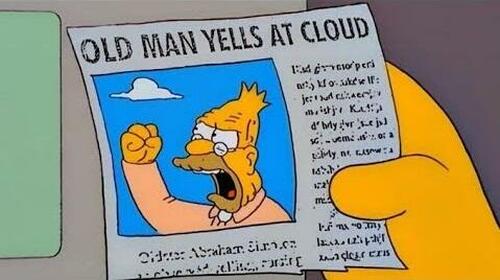
Just 2% of likely voters think Ukraine is the most important problem facing the US today.
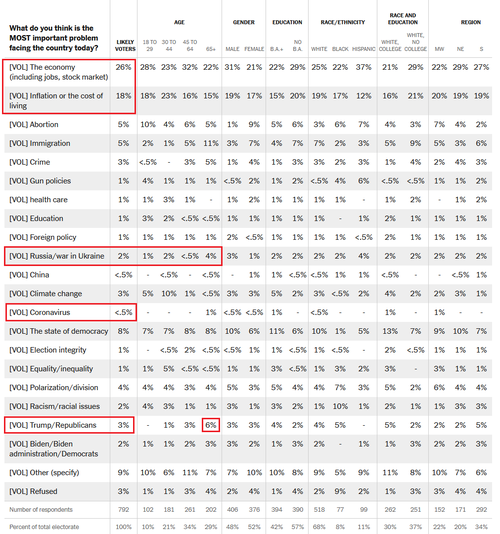
Democrats should also pay attention to Hispanics, who are far more concerned about the economy (37%) than whites (25%) and blacks (22%). That said, 60% of Hispanics – for now, say they’ll still vote for congressional Democrats this fall despite their relatively high disapproval (48%) of Biden.
As noted above, independent voters should be of huge concern to Democrats, as “the poll showed that Republicans opened up a 10-percentage point lead among crucial independent voters, compared with a three-point edge for Democrats in September, as undecided voters moved toward Republicans,” according to the Times.
“I’m shifting more towards Republican because I feel like they’re more geared towards business,” 37-year-old Democrat mortgage loan officer Robin Ackerman in a statement to the Times. Ackerman said she disagreed “1,000 percent” with the Supreme Court’s overturn of Roe v. Wade, “But that doesn’t really have a lot to do with my decision.”
“I’m more worried about other things.”
When it comes to 2024, 46% of Republicans say they’ll vote in the primaries vs. 37% of Democrats. 9% were unlikely to vote. On the right, 47% would vote for Trump over Florida Governor Ron DeSantis (28%) – which the Times felt the need to sound out.

As the Times aptly notes, “Democrats have no margin for error in 2022 — with the slimmest of majorities in the House and a 50-50 Senate, where the flipping of a single seat in that chamber would deliver a Republican majority.”
Will Democrats maintain their dominion over Congress in three weeks?
end
The Mississippi River is drying up
| Robert Hryniak | 5:40 PM (3 minutes ago) |   | |
to |
This is a real threat to hegemony for America. The river has been a cornerstone of American greatness providing a natural mess for transport of grains from the Midwest to coastal ports.
With this means America would have never achieved its’ greatness.
III B USA COMMODITY PROBLEMS//INFLATION WATCH
SWAMP STORIES
States Seek To Depose Fauci, Other Top Officials In Big Tech–Government Censorship Case
MONDAY, OCT 17, 2022 – 05:40 PM
Authored by Zachary Stieber via The Epoch Times,
Plaintiffs in the high-profile case that’s uncovered evidence of big tech companies and government officials colluding to censor users are seeking to depose 10 top officials, including Dr. Anthony Fauci.
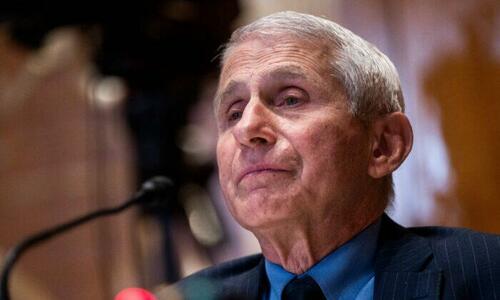
The attorneys general of Louisiana and Missouri and other plaintiffs asked a U.S. court in a recent motion to allow them to depose Fauci, President Joe Biden’s chief medical adviser; FBI special agent Elvis Chan, former White House press secretary and current MSNBC pundit Jen Psaki, Surgeon General Vivek Murthy, a Biden appointee; and Rob Flaherty, deputy assistant to the president.
They also want to question five other officials, including Carol Crawford, chief of the Centers for Disease Control and Prevention’s Digital Media Branch.
While emails and other documents uncovered in discovery have revealed an “enormous and far-reaching” censorship enterprise, the discovery “makes very clear that federal officials have frequently engaged in their most telling and probative communications with social media companies orally, not in writing,” plaintiffs said in a joint statement with defendants.
“Perhaps not surprisingly, the more senior the federal official involved, the more likely they appear to have been to rely on oral, rather than written, communications to pressure social-media platforms to censor,” the statement also said.
Fauci, for instance, communicated in a long-shielded phone call with some scientists who went on to write a paper castigating others who were open to the theory that the COVID-19 virus came from a laboratory in Wuhan, China, where the first COVID-19 cases were detected.
Fauci was also in touch with Facebook CEO Mark Zuckerberg, but the content of oral communications between the two “is yet to be revealed,” the new filing, dated Oct. 14, says.
Fauci has not made any statements under oath about his communications with big tech firms like Facebook, despite the judge overseeing the case ordering the government to provide answers from Fauci to questions, plaintiffs said.
Missouri Attorney General Eric Schmitt and Louisiana Attorney General Jeff Landry, the lead plaintiffs and both Republicans, announced recently they planned to seek depositions but had not identified any officials who they would seek to depose.
Proposed Schedule
Plaintiffs want U.S. District Judge Terry Doughty, a Trump appointee overseeing the case, to greenlight the 10 requested depositions. If Doughty agrees, the depositions would take place during a 30-day window.
Doughty already agreed to the plaintiff’s request to expedite discovery. That led to the production of hundreds of pages of documents, which bolstered plaintiff claims of Big Tech–government collusion.
In that order, Doughty said plaintiffs could alert defendants to any depositions plaintiffs wished to take, and that the parties would then meet to confer on any deposition requests.
If the parties did not agree on the depositions, then they were to file a joint statement outlining their differences.
Doughty has seven days to rule on the new filing, which included objections from the government.
…
Plaintiffs said the arguments in opposition were meritless and should be rejected.
The descriptions of some officials as too “high-level” to be deposed is outweighed by the fact that the officials all have firsthand knowledge of the matter and the information they hold cannot be obtained elsewhere, plaintiffs said, referring to a ruling in a separate case, United States v. Newman.
…
KING REPORT
END
GREG HUNTER REPORT
WILL SEE YOU TOMORROW



[…] by Harvey Organ, Harvey Organ Blog: […]
LikeLike
[…] by Harvey Organ, Harvey Organ Blog: […]
LikeLike